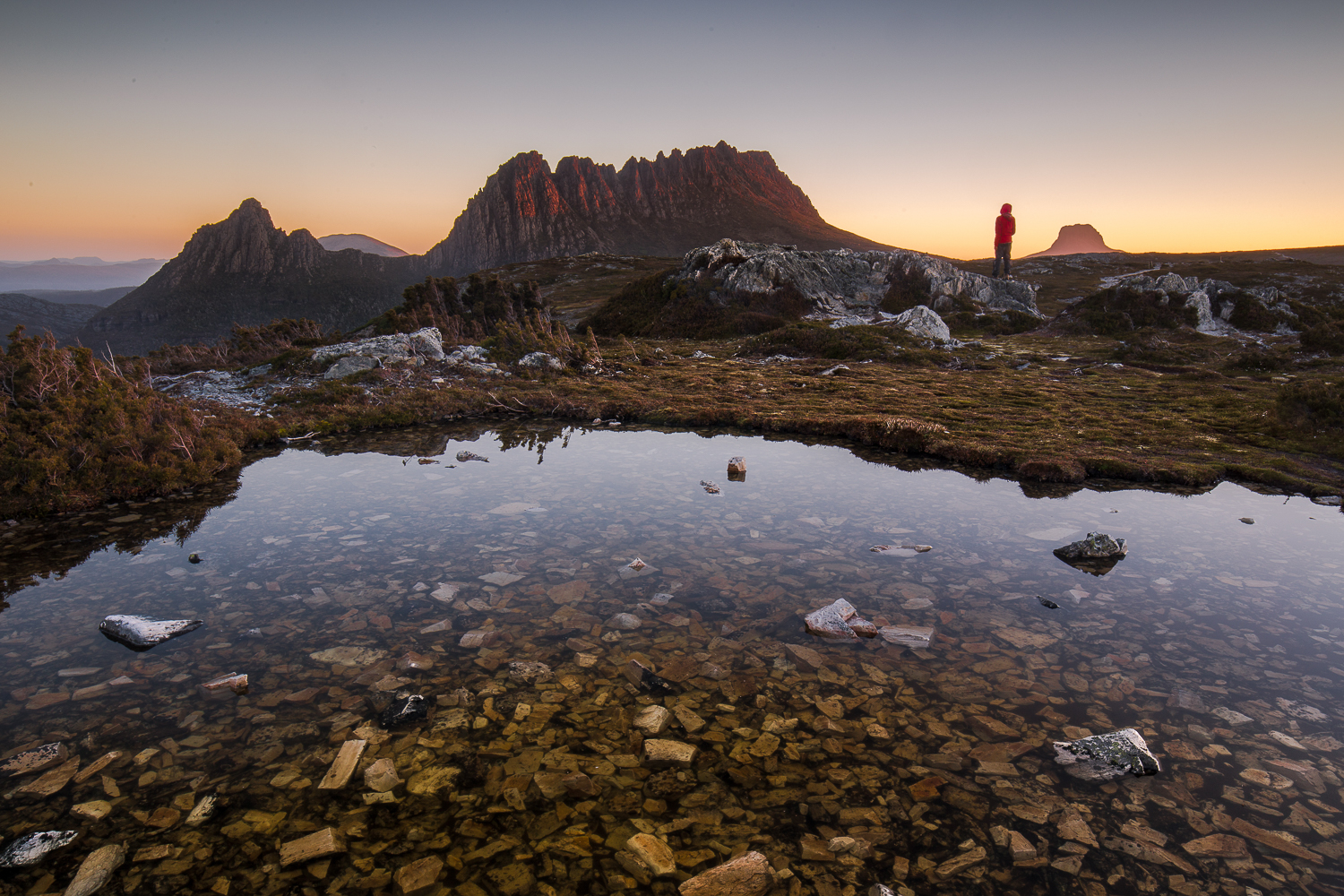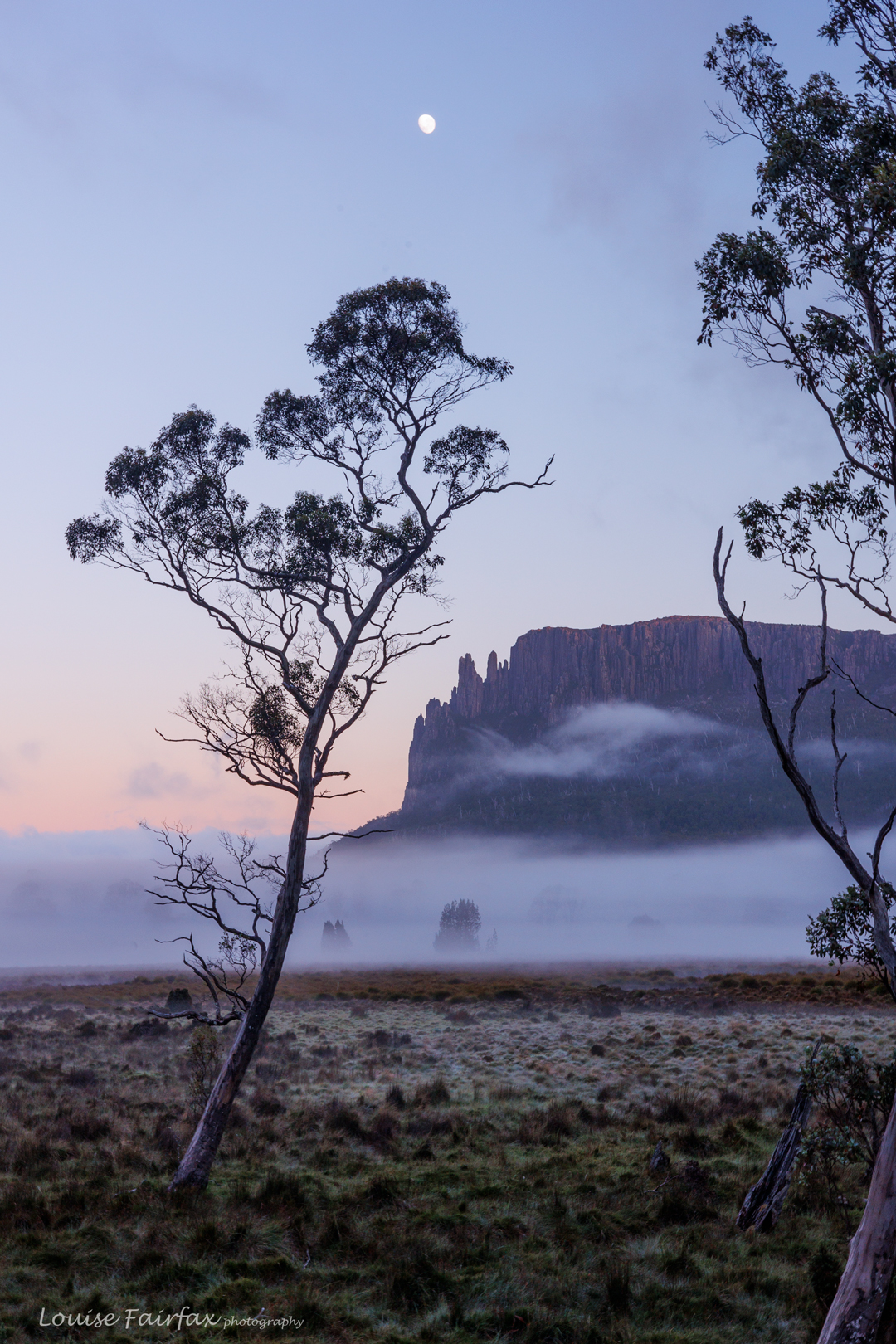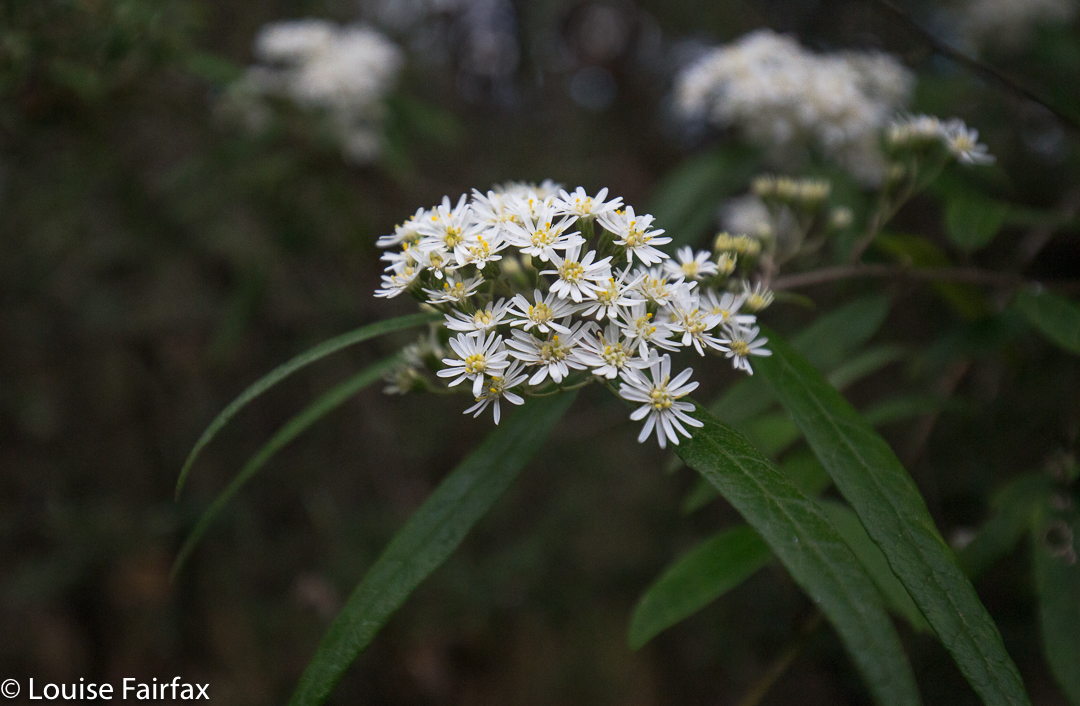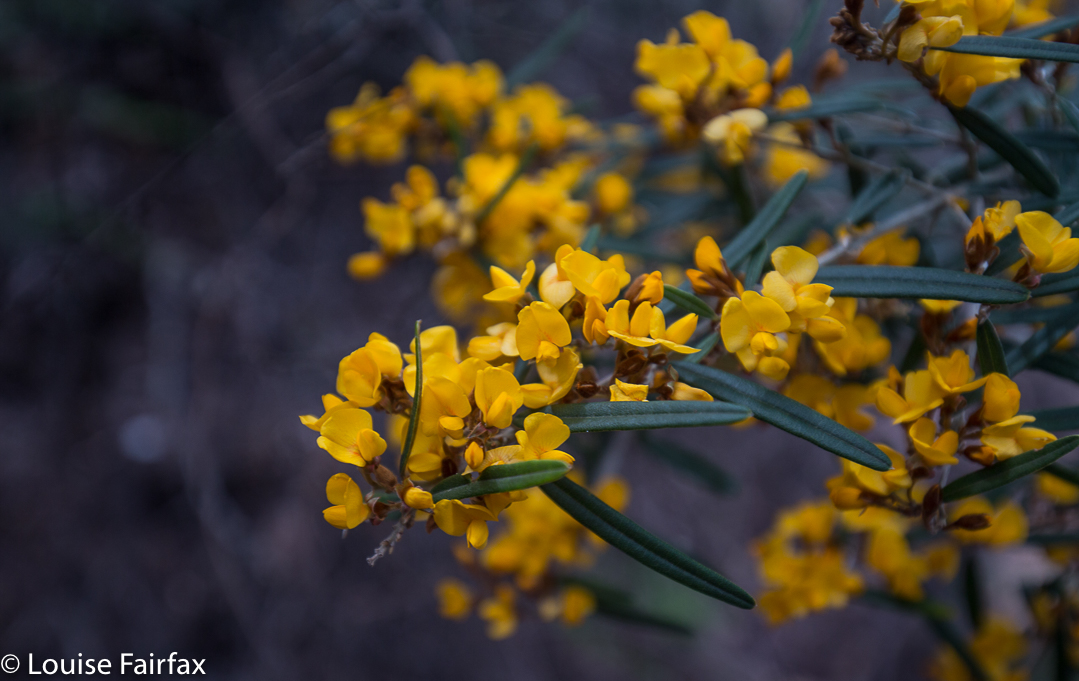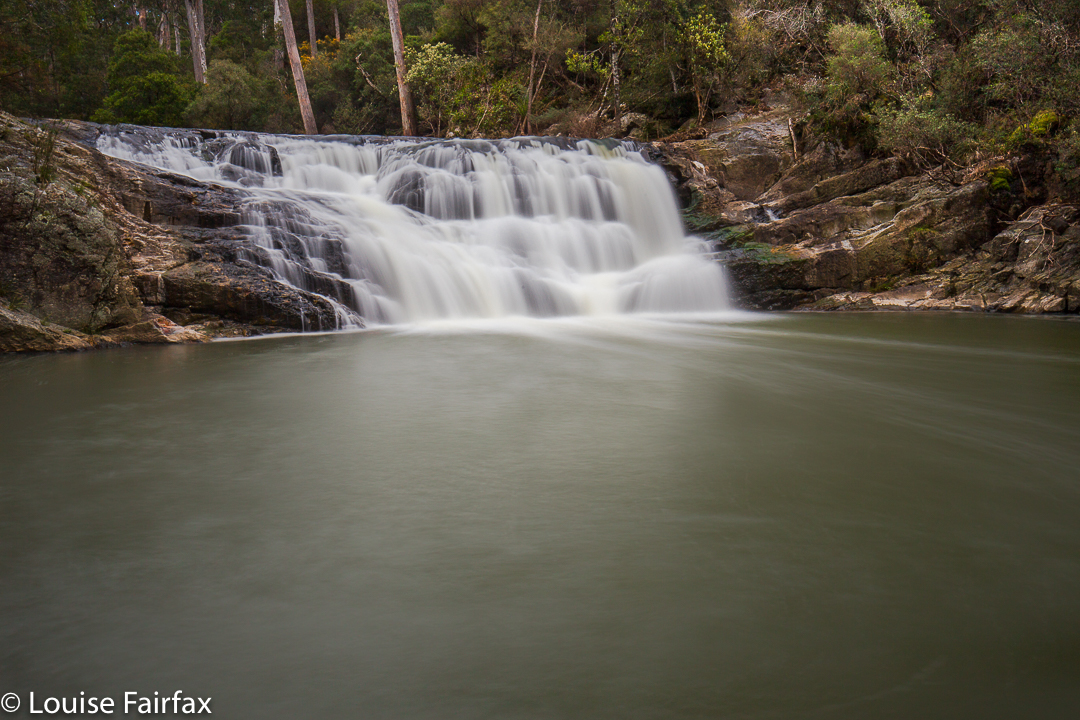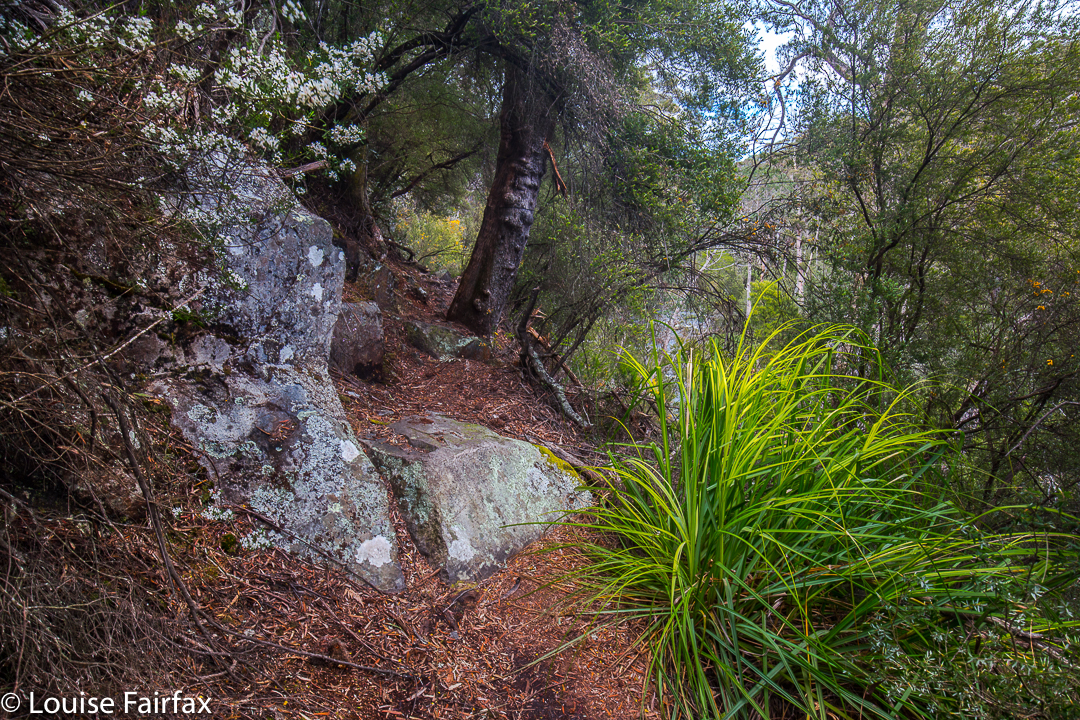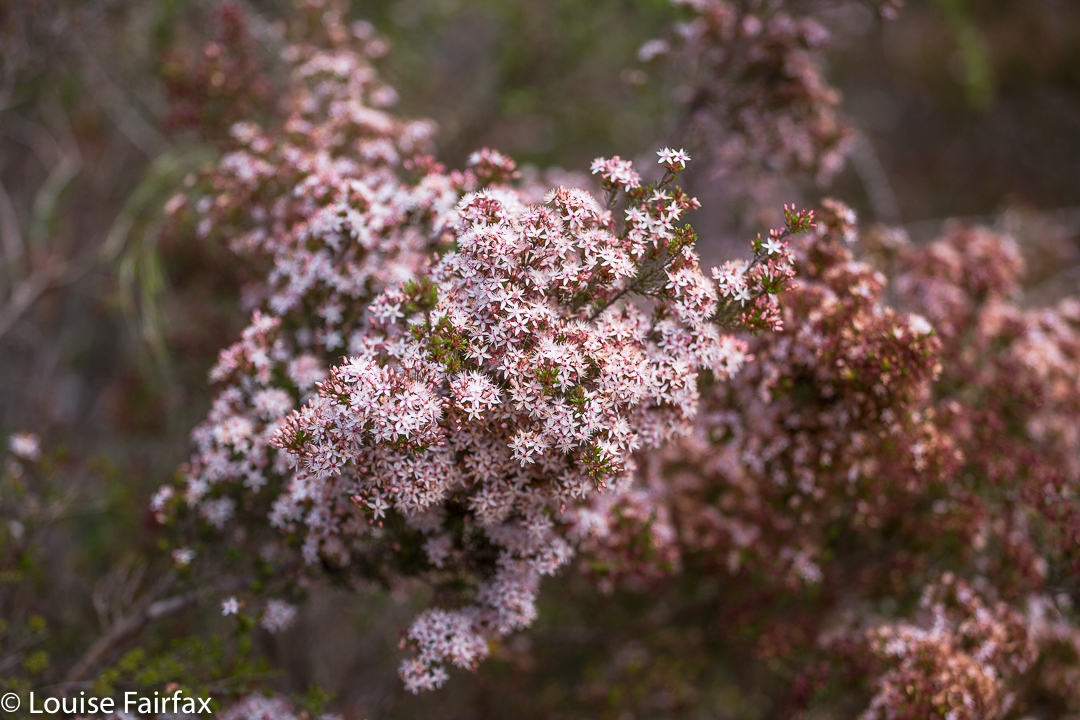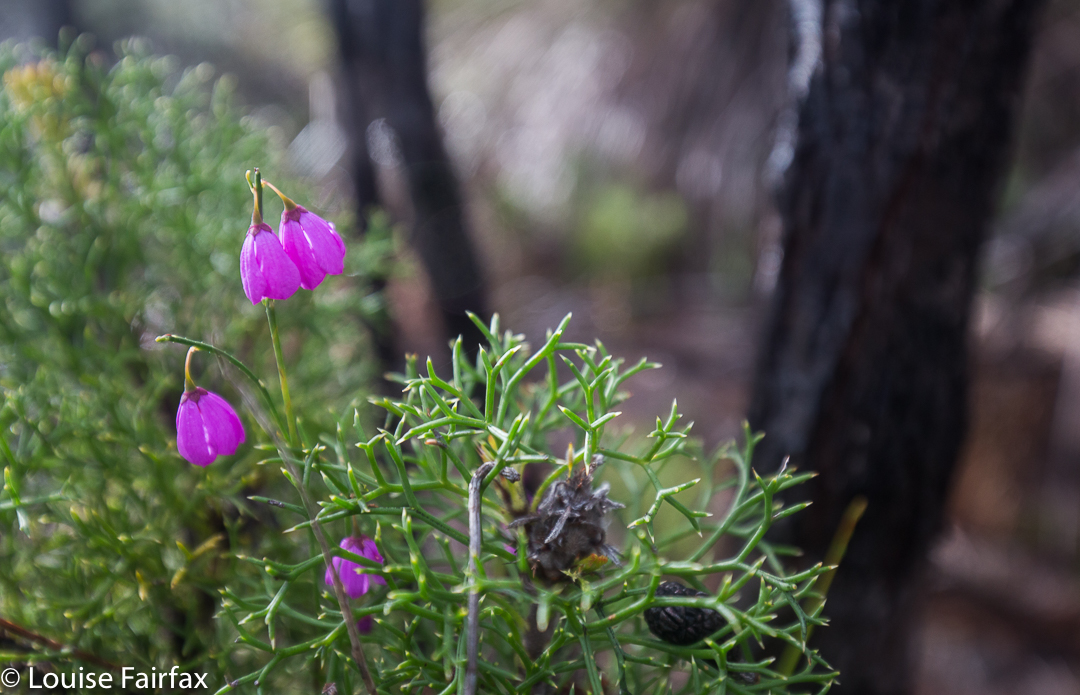This trip to Mts Ossa and Oakleigh was a trip in which I didn’t do anything I was supposed to do, but ended up doing wonderful alternatives, seeing some absolutely magnificent scenery (including the best wildflower display ever), and meeting heaps of incredibly nice people.
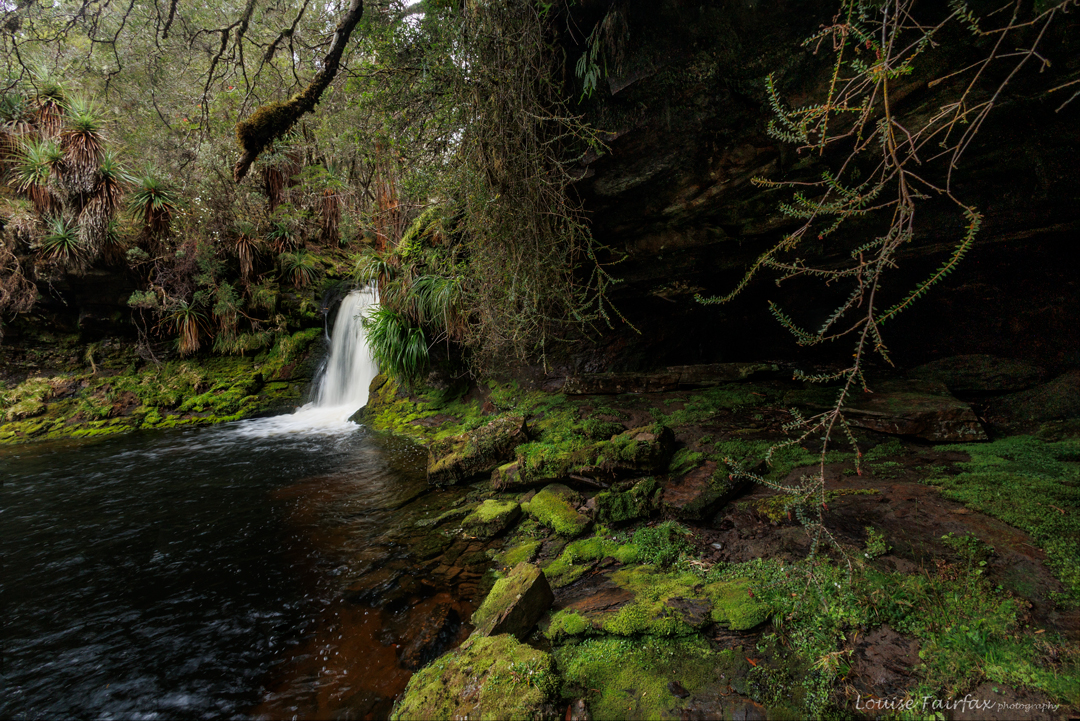
So, for starters, I left on the “wrong” day. Originally, we were to leave on the Monday, so I had booked my dog into the kennel, and even delivered her, before I got news we were now to leave on the Tuesday (due to bad weather coming). But my dog was already gone, and I had ants in my pants. I decided to just weather the weather and set off anyway, do my own thing for a day, and then meet the others. As it turned out, A and T had decided similarly, so three of us set out early.
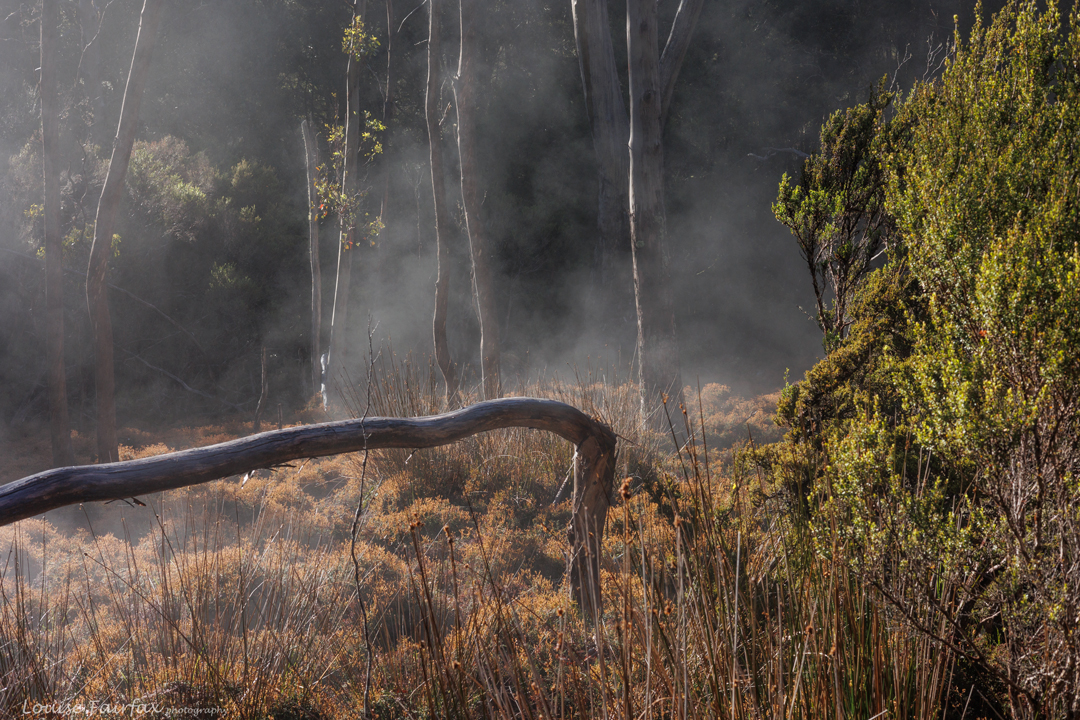
A and T elected to sleep in Pelion hut, reached after a few hours’ walking, but I unctuously declared that I was bushwalking, so would sleep in my tent, not in a hut. Tent pitched, the rainforest in all directions from the hut thoroughly explored, and several streams followed, I went down to the hut to be sociable. There were some terrific people in the hut, and I had lots of pleasant and interesting conversations until it was time to depart for bed, for which I had to wait for a break in the deluge.
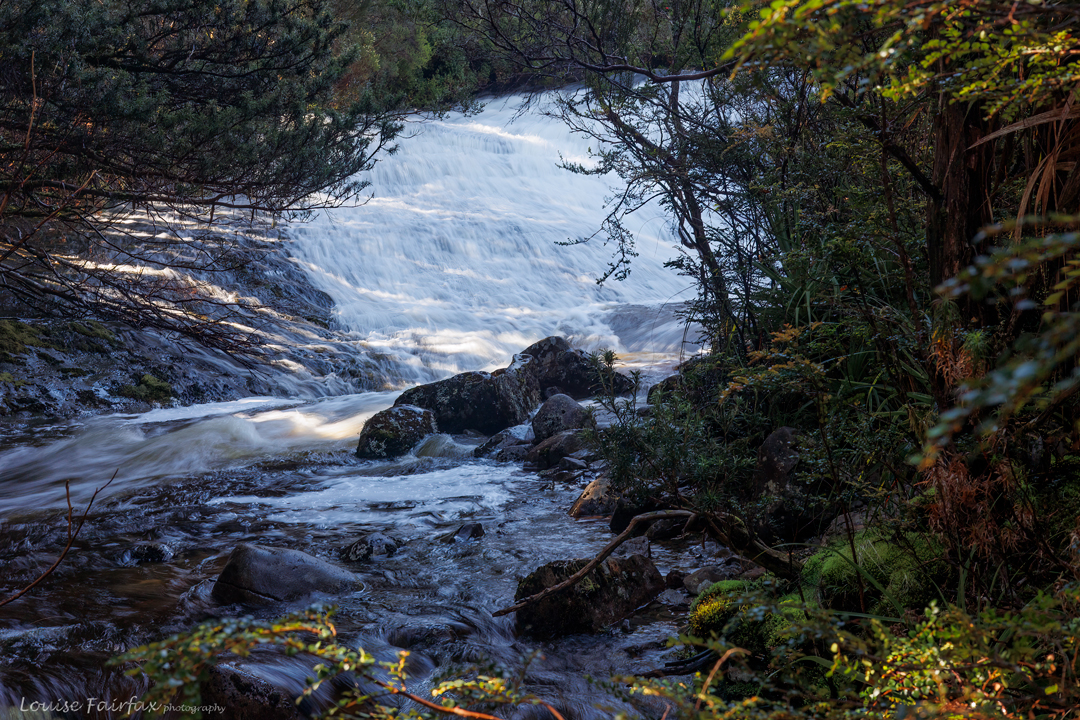
The phrase “bucketing down” gained a new meaning that evening, as I waited for a pause in the tumultuous downpour to run the fair distance to my little isolated tent. I have never heard rain quite so loud, never seen sheets of rain quite so solid. Squadrons formed on the verandah to enjoy (and many, to try to photograph) the wild display. Conversation while it was happening was impossible.
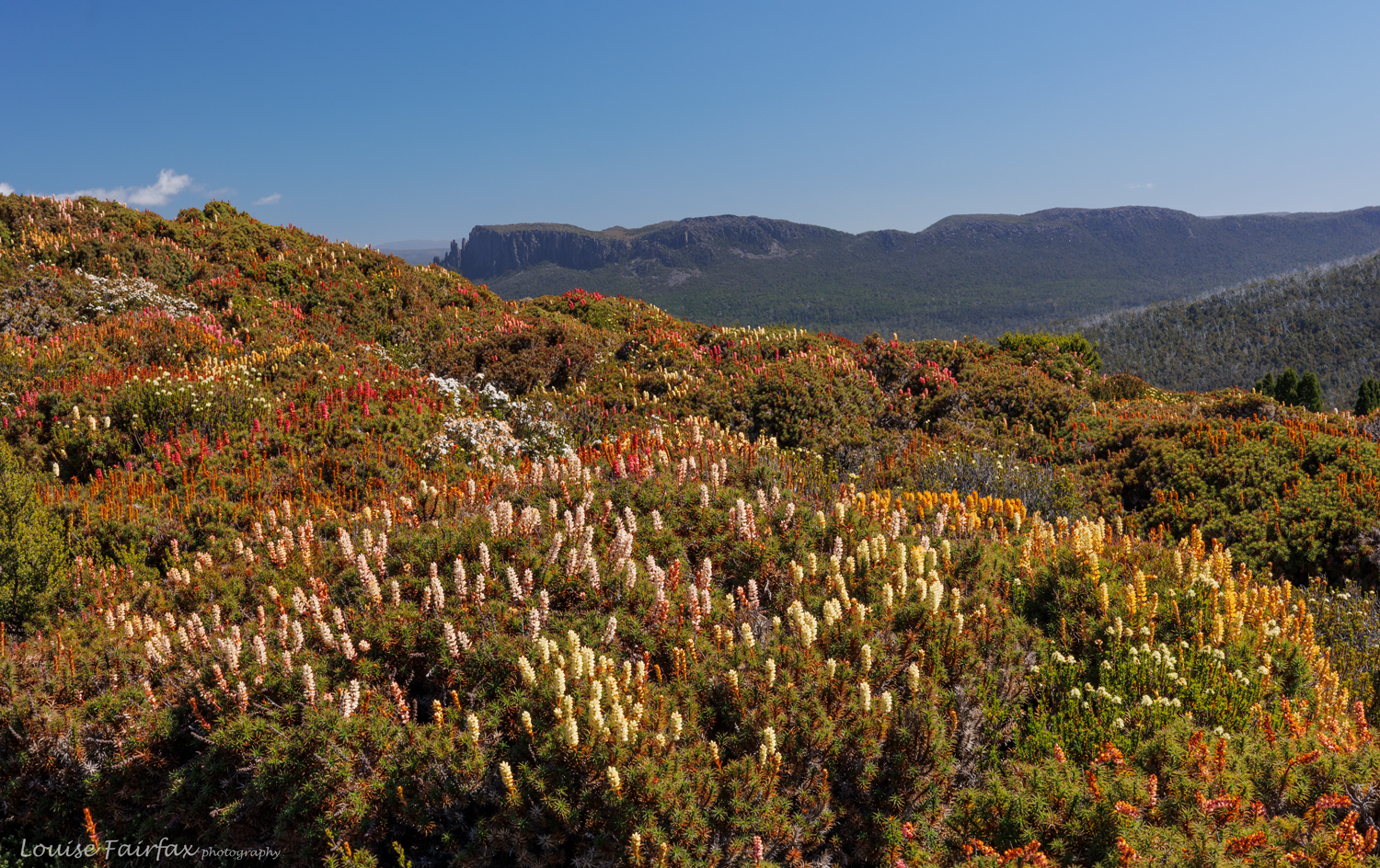
That night the mother of all storms rolled in. The thunder was roaring like a sick lion, the noise ricocheting from mountain wall to mountain wall in the audience of mountains surrounding us. The rain continued to flood the plain. I considered the fact that I was somewhat vulnerable lying there under trees should one of them get struck by the lightning that accompanied the noise, but, well, that is nature: threatening. I was aware of the danger, but also philosophical about its potential to harm. I have enormous respect for nature, so was not lying there like a fool thinking it could never affect me, or that I could somehow control it. What would be would be. Emanuel Kant would call the experience of us tenters “sublime” as we were taken into the realm of fear and our own vulnerability, yet emerged safely out the other side. Those in the hut barely noticed what they were in the middle of. Most had ear plugs in, and were also locked away from the flashing lights of electrical power. I am glad to have experienced nature in such a wild frenzy.
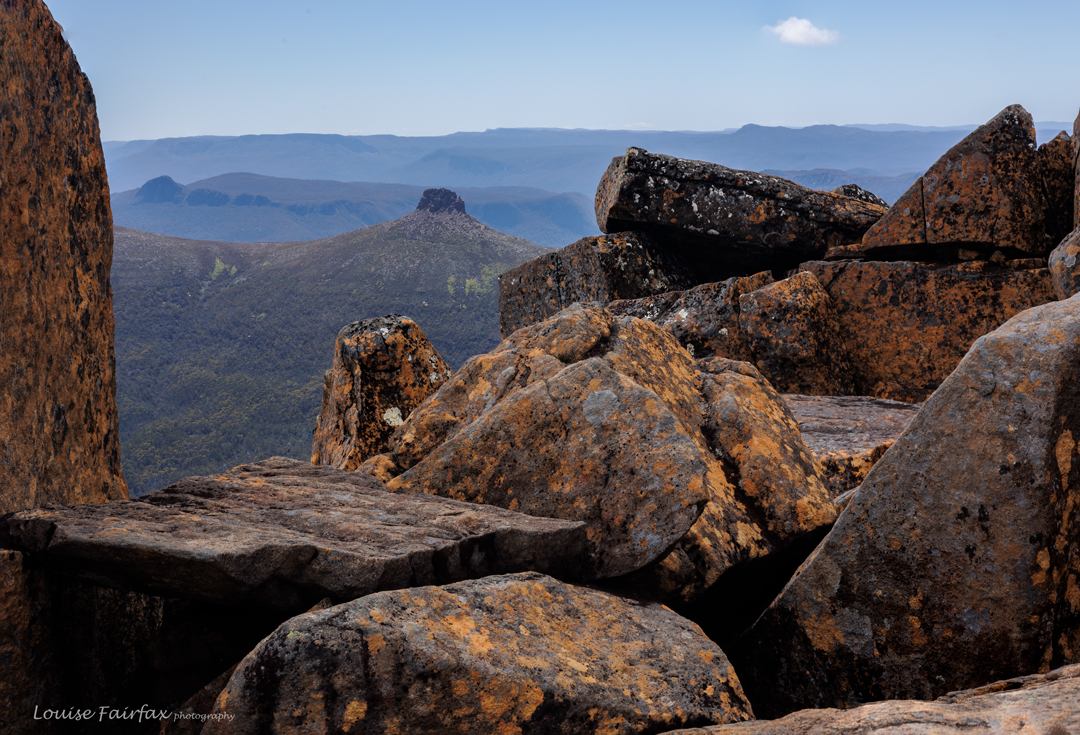
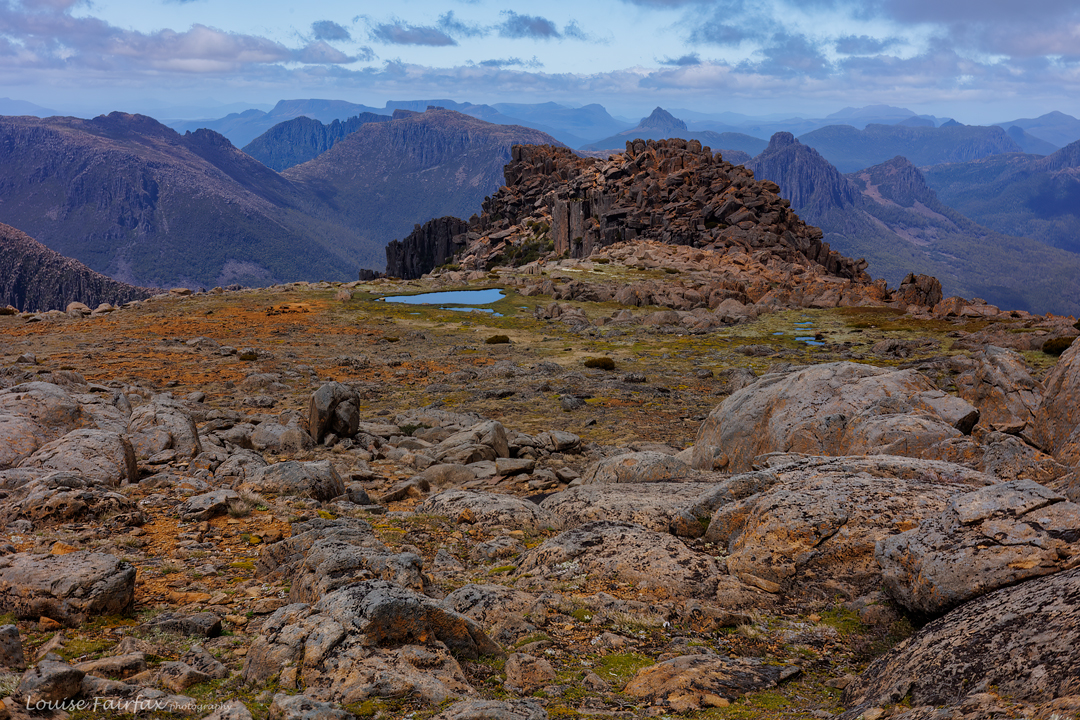
During the night, whilst listening to the drama, I noticed that water was falling on my face. I reached for my torch and discovered it was sopping. In mild panic I rescued my beloved camera and gps device and put them as high as I could, but was not confident, as my face was still being splashed. I did my best. My sleeping bag was more than moist. An hour later, I notice that my pillow – that is, all my emergency dry clothes, in a drysack – were now also wet. Somehow I fell asleep anyway.
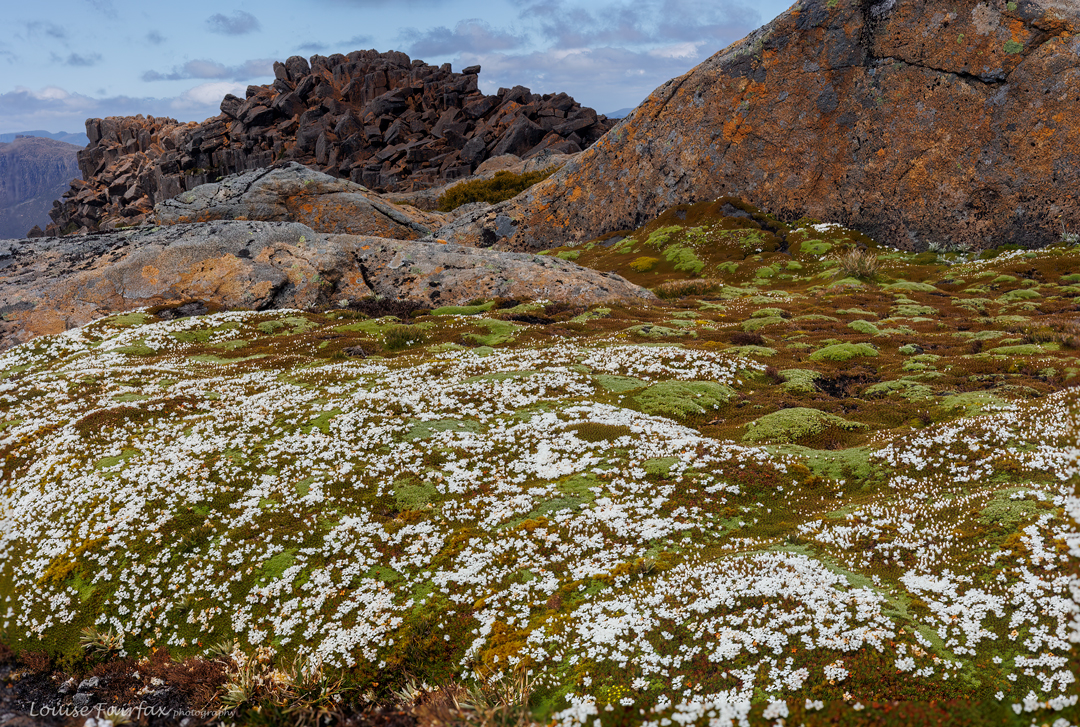
In the morning I awoke to the sight of a lake in my tent. Other plans I had made for this day to be spent at my will were now cancelled, as drying my stuff in the hut became my primary objective. First, however, I wanted to do something for exercise, so went up Mt Oakleigh in the rain (third time). The lush, mossy myrtle forest was magnificent in the mist. On the top rocks, the wind was blowing furiously and it was very cold. I had achieved my daily quota of exercise, so that was fine, and now I could try to dry things out to prevent hypothermia that night. High resolves cancelled, I moved into the hut. (No photos of Oakleigh; that might have killed my camera).
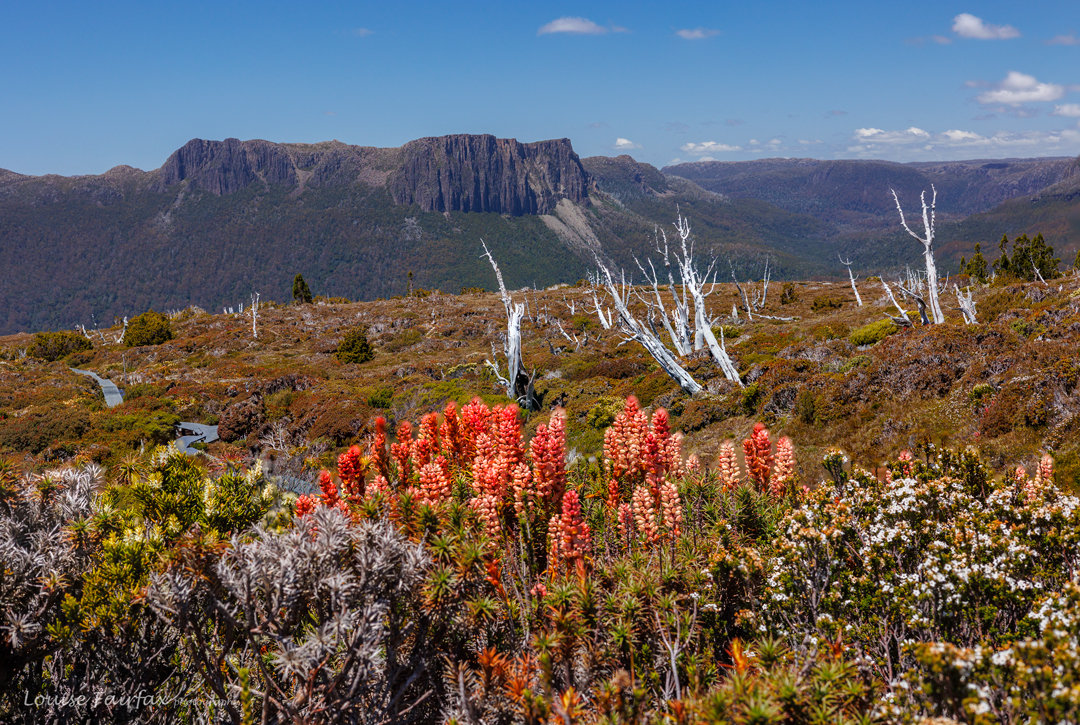
The next wave of Overland Trail walkers entered: another group of really nice people with new friends to be made. They were most solicitous about my gear, and many helped me turn and rearrange items to get them dry. We chatted around the heater meanwhile – hardly unpleasant. I was anxious to finish as quickly as possible, as these people were wet from the day as well, so we all needed to dry things. Amongst the smiling faces was a friend of my daughter’s from primary school in Canberra. It was fabulous to catch up with him and his family. I was really warmed to see so many children on the trail happily experiencing this initiation ceremony into distance bushwalking. They were happy, loved to tell me about the birds and other aspects of nature they had seen. I loved meeting them.
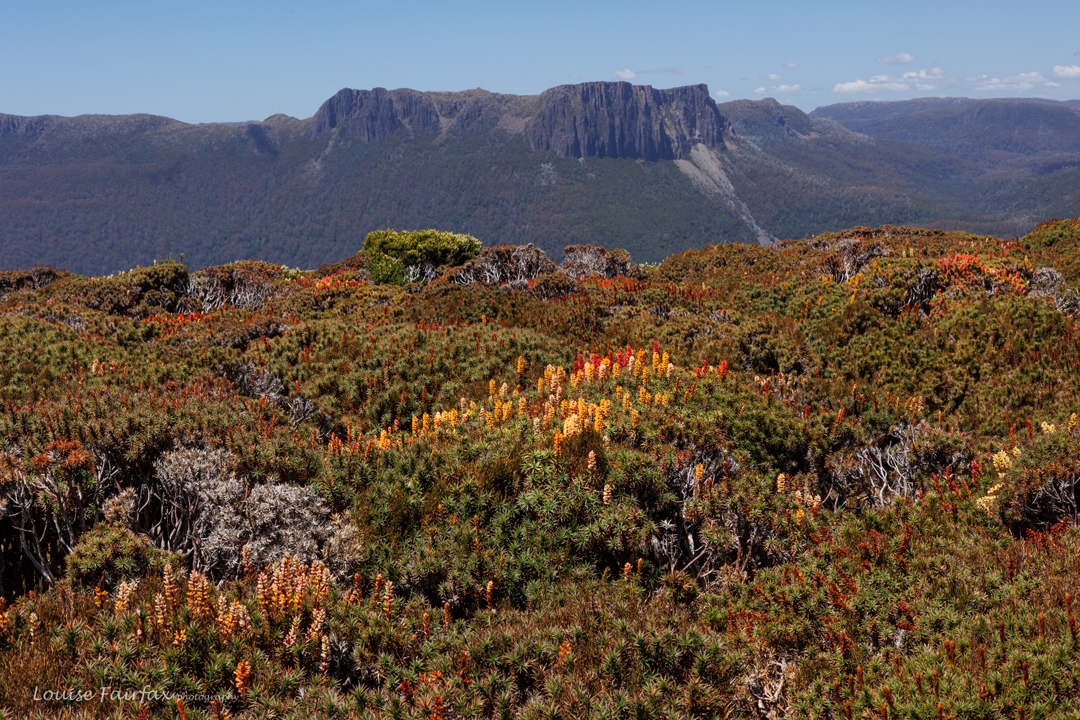
The people we should have met passed through, sopping and freezing. Not one of the three of us joined them in the planned further hour and a half’s walking. I needed to get dry before I could get wet again. My tent was still a swimming pool. Two days down. No previous plans fulfilled.
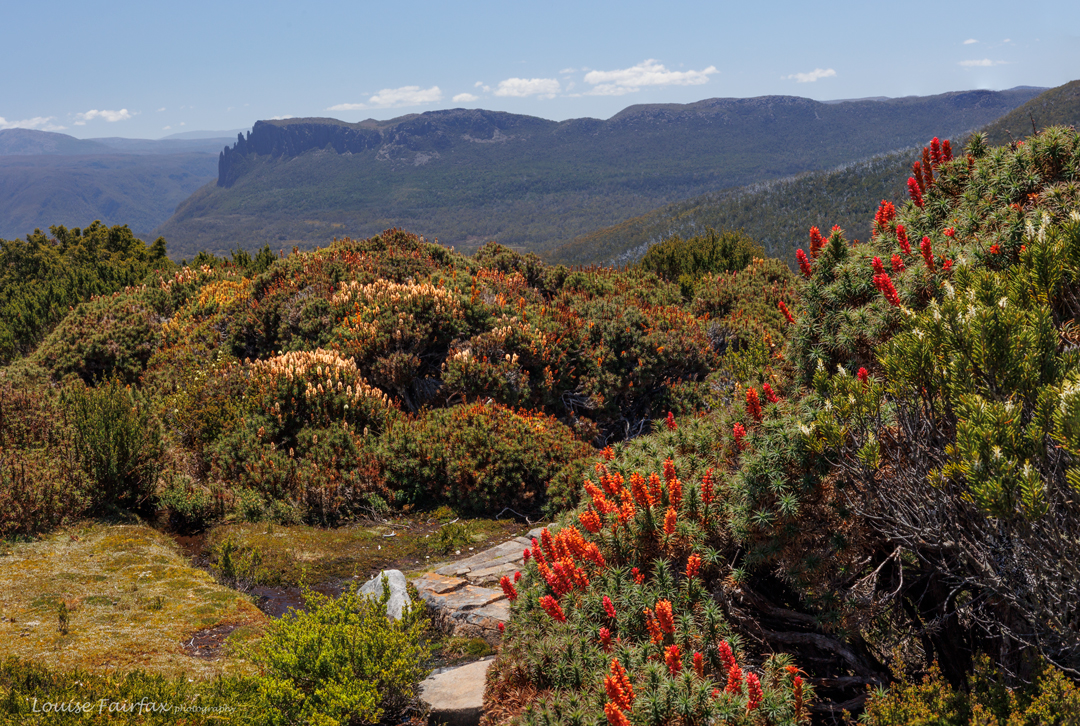
On day three, the others were climbing Proteus. My tent needed attention, and Proteus hadn’t thrilled me the first time I climbed, so I wasn’t going to cry over that lost opportunity. I scooped NINE cups of water out of the tent and hoped that by the time I got back from Mt Ossa, which I had decided to climb as a shorter alternative, it would be dry, and I could join the others for Pelion West.
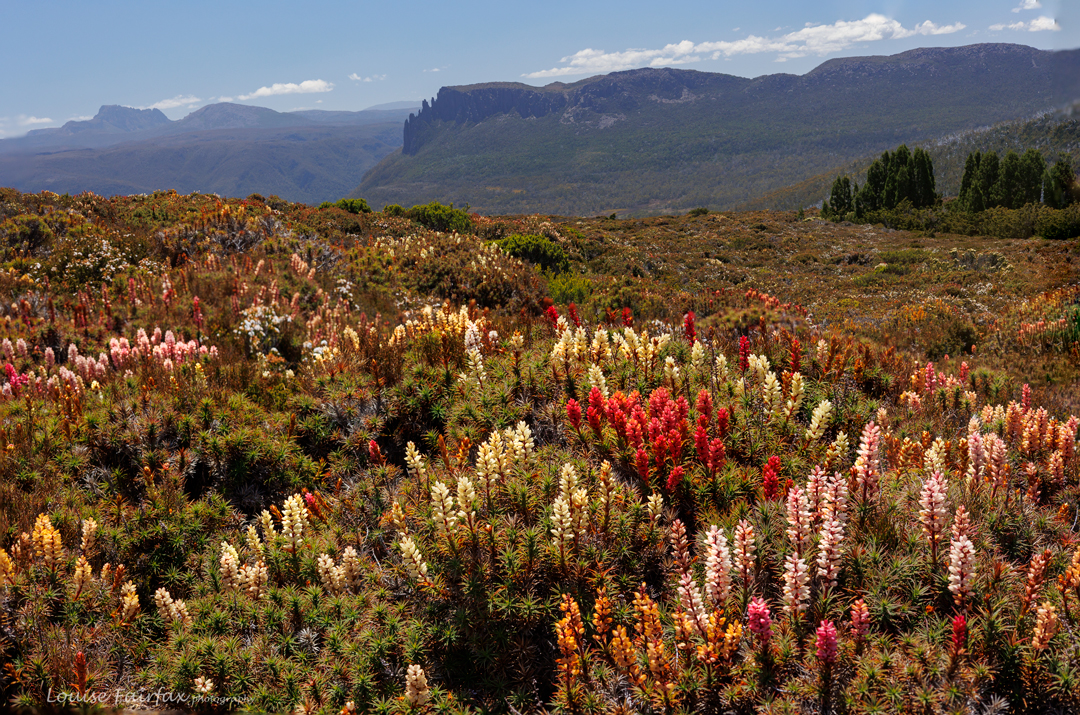
I have never seen such a varied wildflower display on Ossa. I have climbed it seven times now but never have I seen it quite this colourful. I was floating on the wave of its beauty. Striated emu wrens flitted from bushtop to bushtop, and other birds I couldn’t see (or identify by their chirps) called to me and teased me. Apart from their twinkles and tweets, the bush was deliciously silent. I played on the summit, and on anything I could find on the way down. I didn’t want to leave the flanks of this mountain today. Luckily for me, my new friends from the hut were climbing up as I came down, so every twenty or so paces, I got to have another chat with people whose faces I now knew. It was a very sociable descent. Back at the saddle, I was still reluctant to leave, so walked in the opposite direction to prolong the excursion into flower heaven. I got back to Pelion Hut for lunch after 4 pm, feeling just a little tired. I needed lunch, quickly followed by dinner. I was in no mood to carry out my plan of packing up and walking two hours to join the others. “I can do that early in the morning”, I said to myself.
-
That night (after a third wave of OT walkers had arrived and befriended me), all of us were … er … “blessed”?.. with the booming thunder of a snorer, trying to compete with the recent storm. His noise lasted much longer, with a regularity that was utterly unnerving. I did a Lazarus, and moved my bed to the kitchen. In the morning I observed that four others had done likewise, We could still hear him through the closed door, of course, but at least the sound as a little muted.
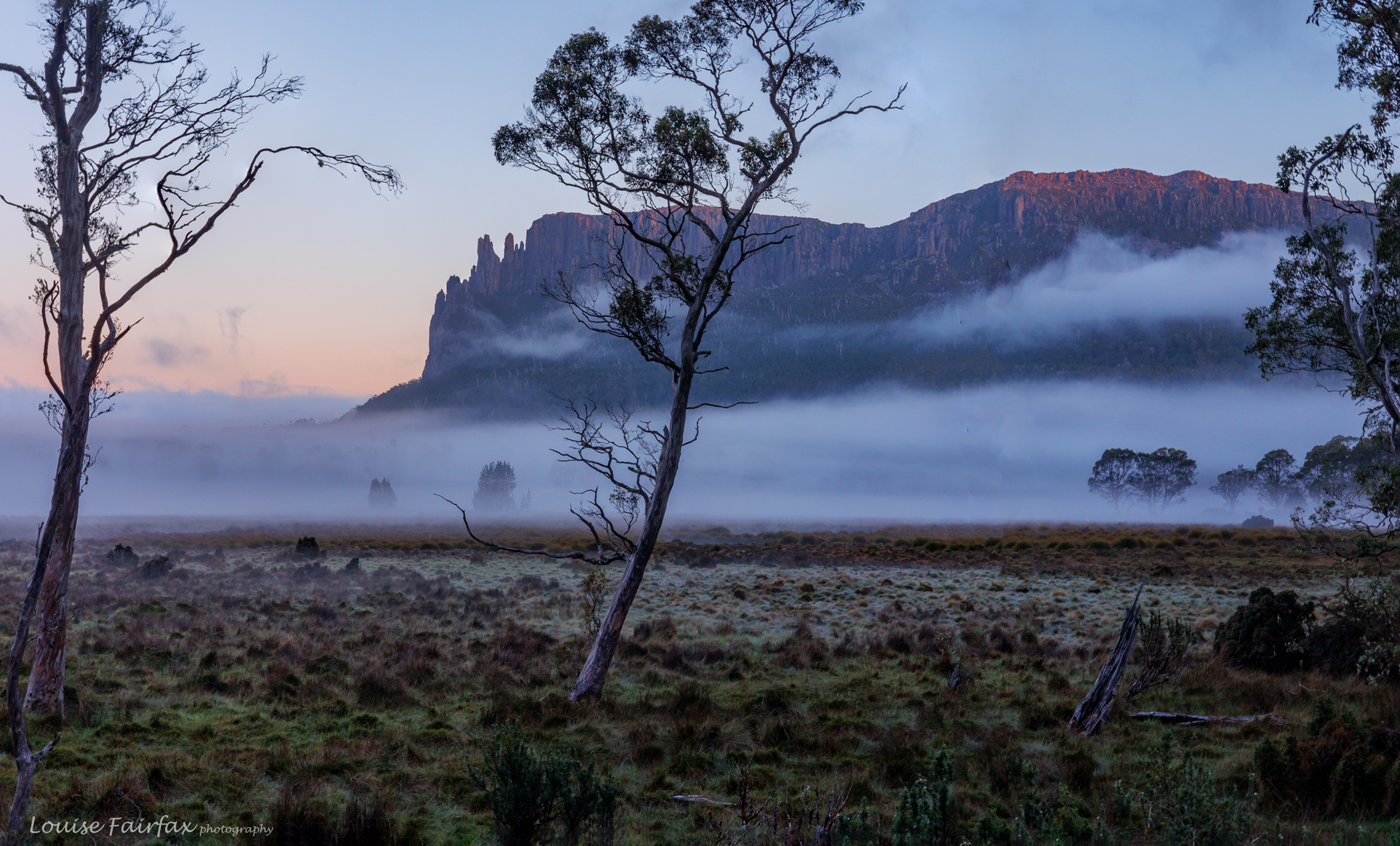
Dawn Oakleigh I was so lucky in the morning, as somebody bumped me, and I thus got to witness a superb dawn. The bumper later sheepishly apologised, but I pointed out that I would be forever grateful. If she hadn’t accidentally disturbed me, I would have missed that wonderful dawn. I had wanted to wake up for it, but was so tired after the many disturbances during the night that without her assistance, I would have missed it.
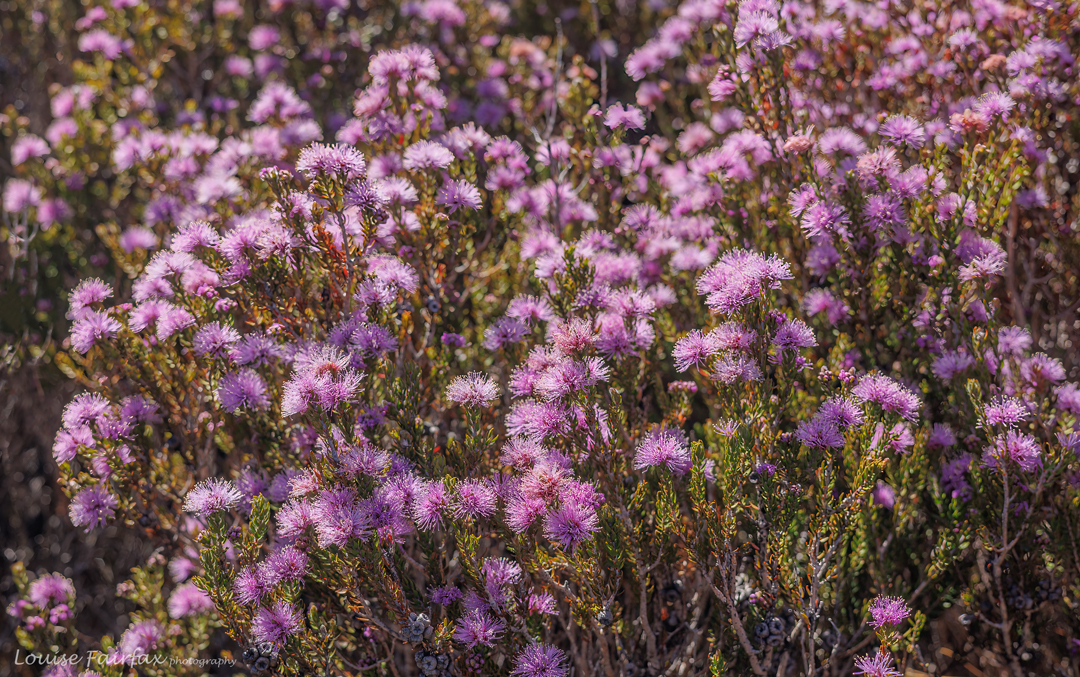
Melaleuca squamea had come into full profusion while I was watching rain. It likes the bog under Mt Pillinger. Exhausted from lack of sleep, and perhaps having picked up a bug, I started feeling sick. I set out to join the others, as planned, but decided that I really didn’t have such a long day in me. It was time to get out. I turned around and returned to the hut. Yet another action that was not according to the orginal plan. My dog, picked up a day early, was thrilled at the unexpected day’s reprieve from the kennel. (It’s a great kennel, but she loves being home with me.) She sang with delight at my appearance, almost dislocating the shoulder of the carer fetching her.
Higgs Track to Lady Lake 2021 Jan
Back in the early 1990s (when I was an athlete), I used to run up Higgs Track for training. The times I did, from the vantage point of my current age, seem daunting. I must try running it again some time to see exactly what damage age has done to me. But that is for some later date. Today I decided to take my tent and camera gear and go up for my first overnighter in the region.
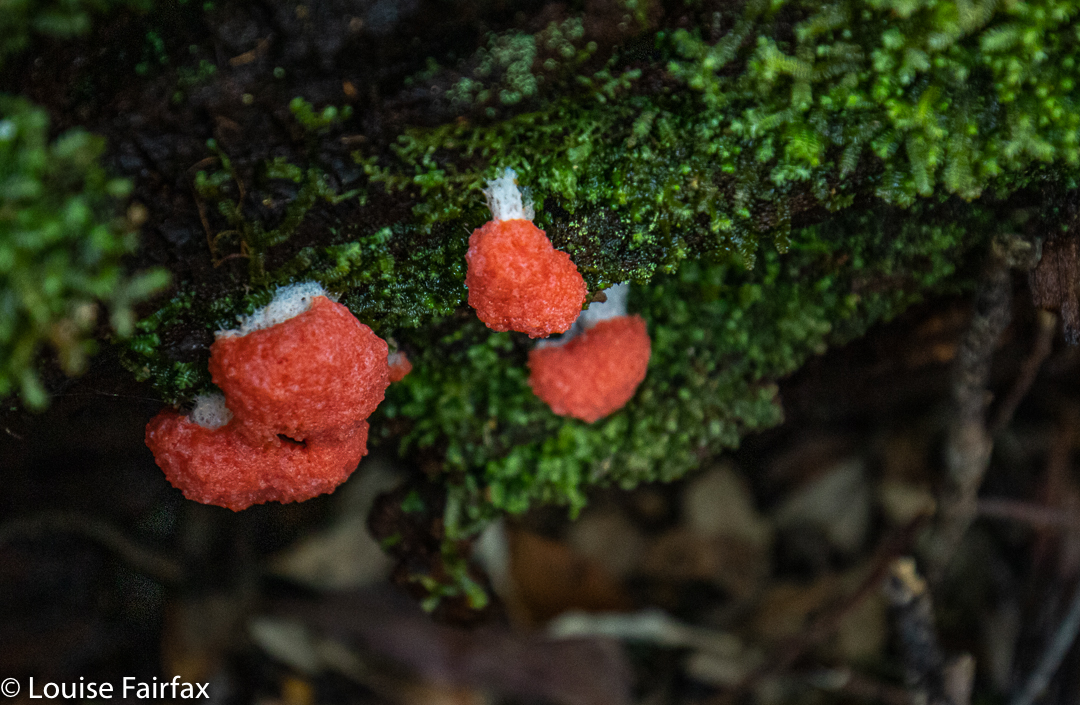
Slime mould Dale Brook. Tubifera ferruginosa. 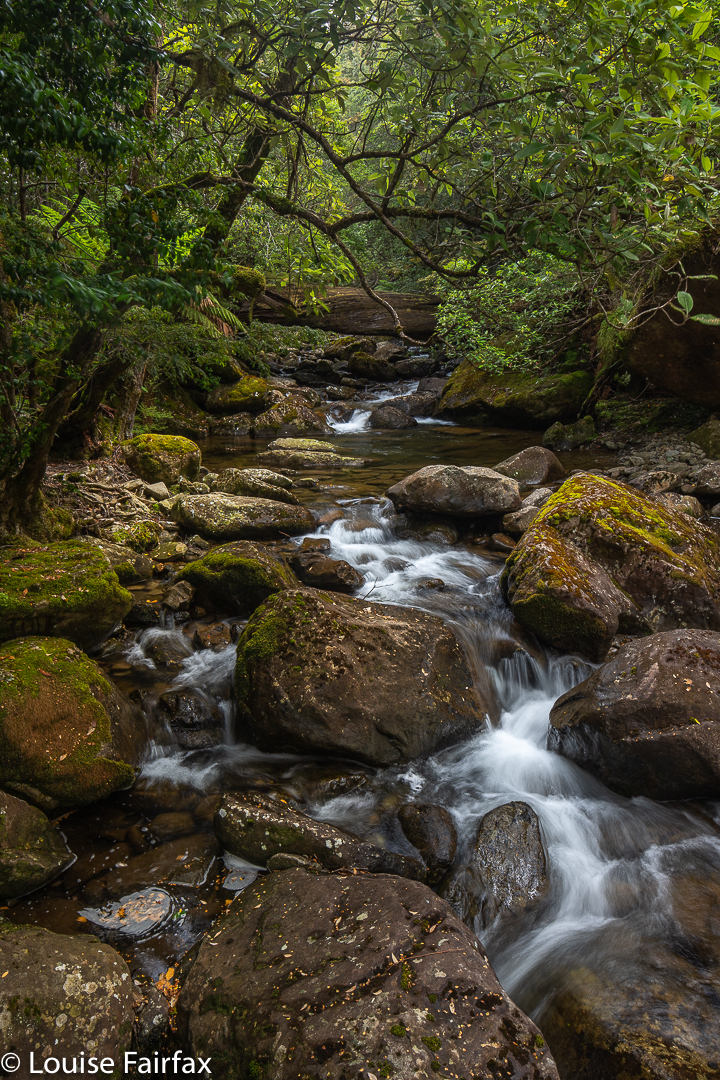
Dale Brook, Higgs Track Running is very different from walking with a heavy pack! The pack forces slowness upon you, and you have extra time to notice more of the tiny aspects of the bush – like fungi. I was not expecting fungi in summer, but photographed eight different genera, which greatly surprised me. (I found more than that, but they were mostly too big and bulky for my tastes; there were also other plain-coloured, middle-sized ones I couldn’t name, and, as no one ever seems able to help me identify that sort of fungus, I left them.)
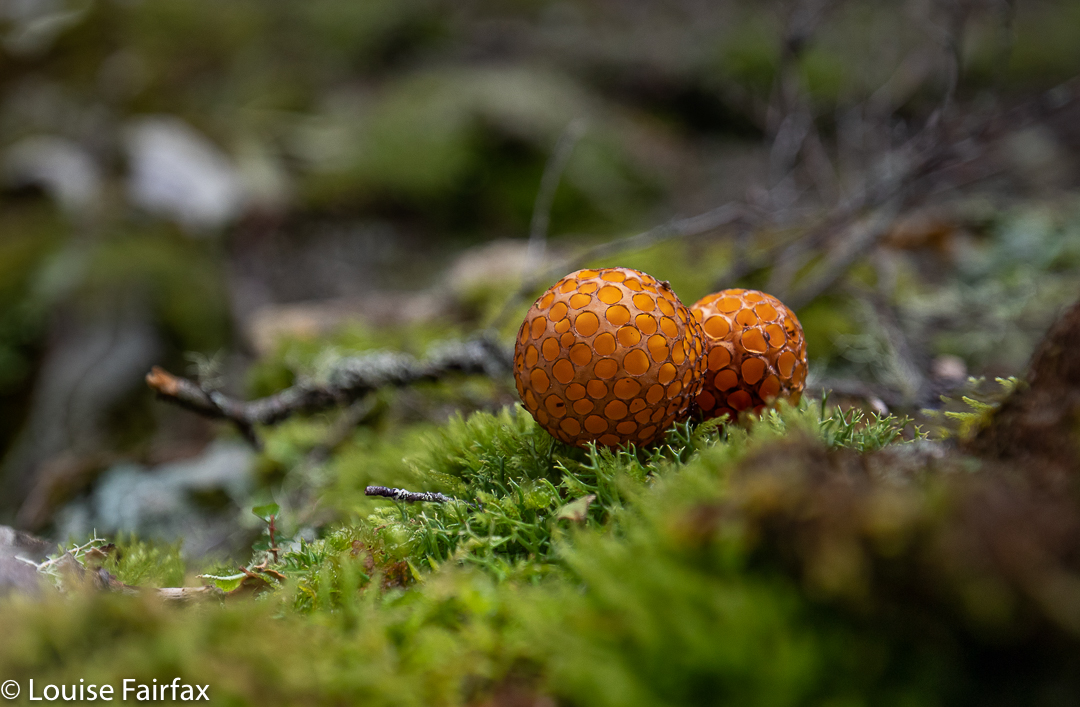
Cyttaria gunnii Higgs Track. There were literally hundreds of these, lying all over the ground, having fallen from the myrtles above. 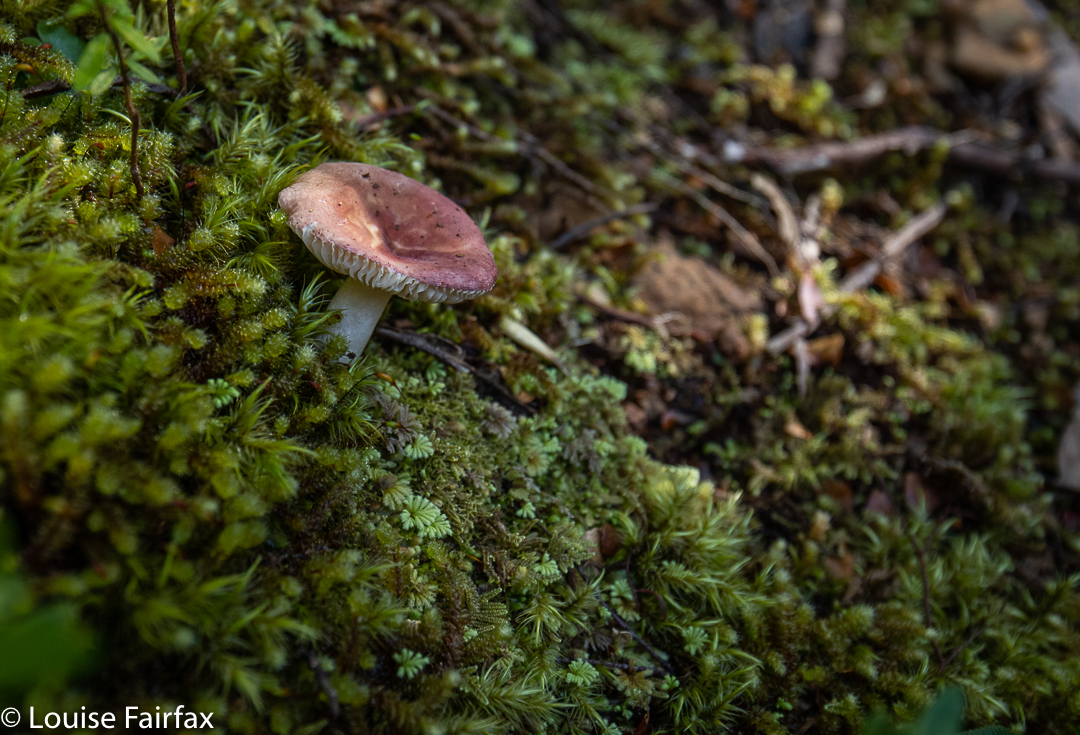
Russula serpillifolia, or a faded persanguinea? Not sure. I will correct this if someone helps me ID. I had forgotten most of what Higgs Track was like. My single dominating memory was that of trying to cross Dale Brook at the start, crawling along a disconcertingly high and usually very slippery log before the climb began. Nowadays, I discovered today, there is a problem-free bridge, so my hesitant anticipation was unnecessary. Meanwhile, the track itself – and the surrounding area in general – was very beautiful indeed, with masses of ferns and moss and rich brown tree trunks. Dale Brook could be heard for most of the trip.
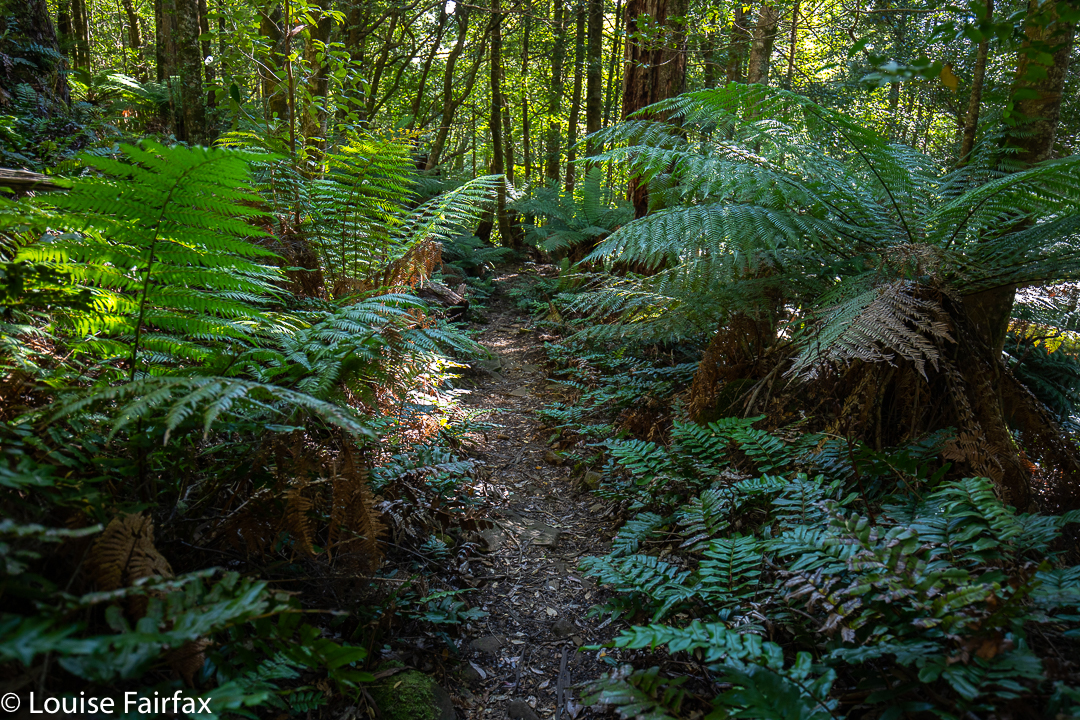
Higgs Track 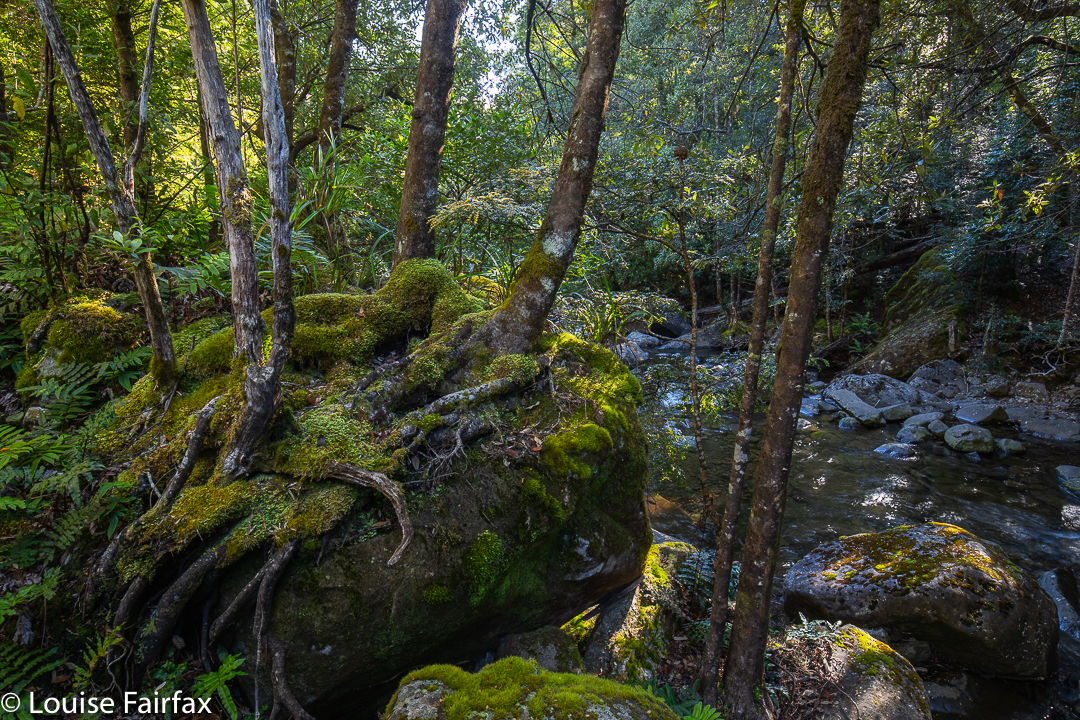
Higgs Track Walking with a pack may well take significantly more than double my running time, but I had still finished the climbing part to the flat plateau at the top in under an hour, so was pleased. This gave me plenty of time to check out the hut, meet its inhabitants and have some soup and dinner before I would set out with my camera gear to see what I could see as the sun got lower.
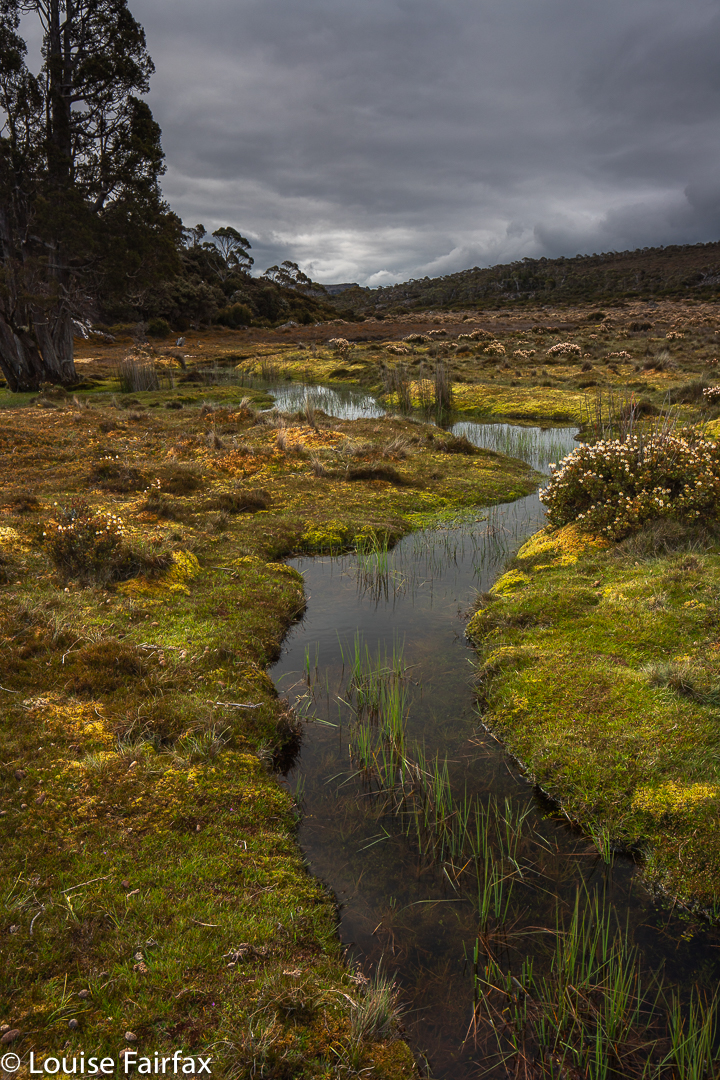
Lady Lake Plains 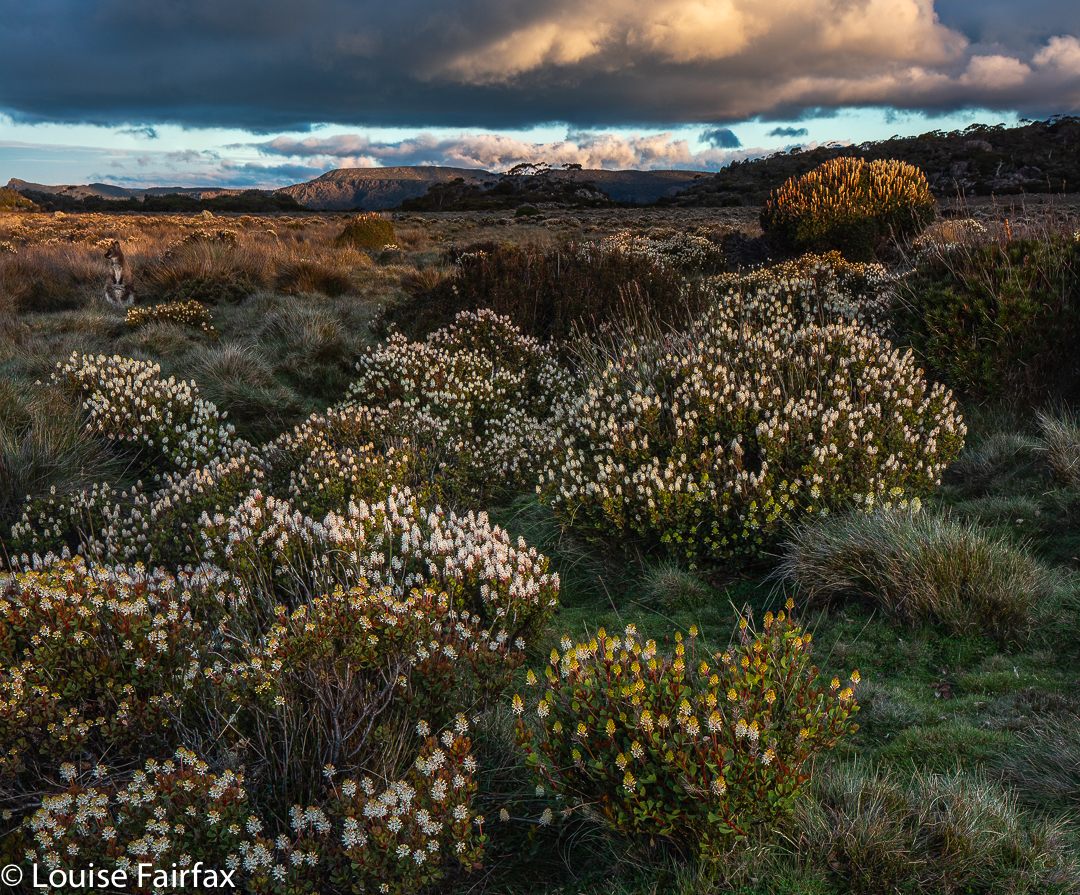
Wallaby in Lady Lake Plains enjoying the twilight. (The flower is mostly Bellendena montana with a Richea scoparia taller behind). Believe it or not, this is a thirty second exposure. What a cooperative model!! The hut inhabitants were friendly and welcoming, so I decided not to pitch my tent, which would mean I didn’t have a wet mess to pack up in the morning. Rain still looked likely. The dark clouds were very attractive, and I was able to enjoy them all the more for the knowledge that they were not going to wet the fabric of my tent, making it heavy next day.
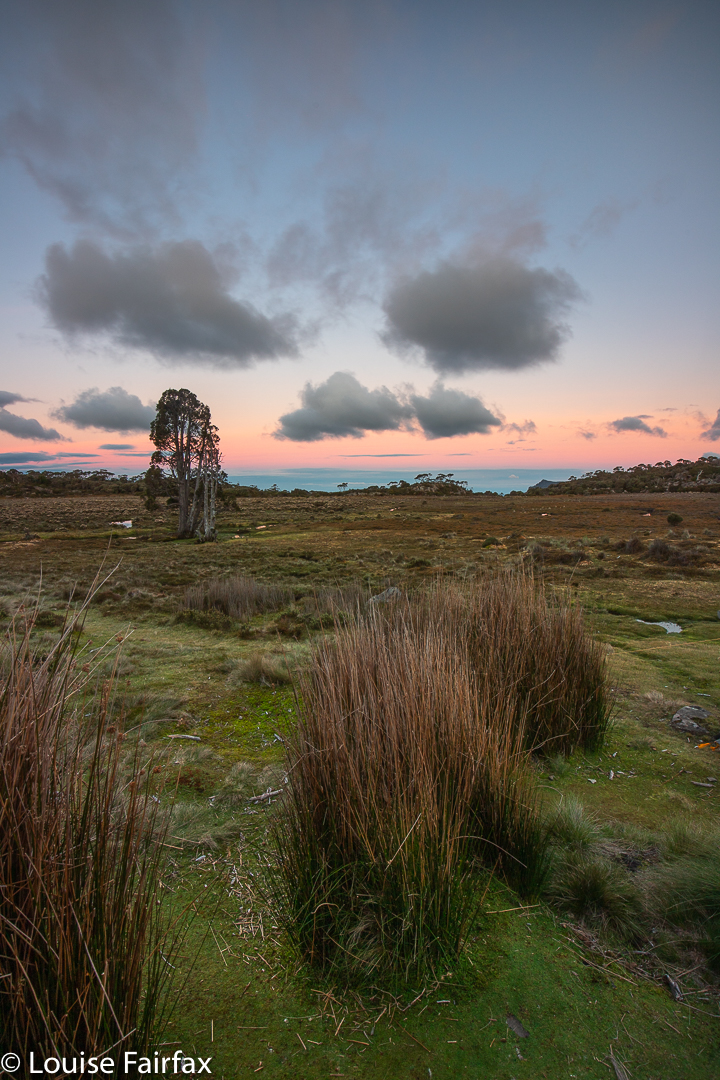
Alpenglow on the Great Western Tiers near Lady Lake 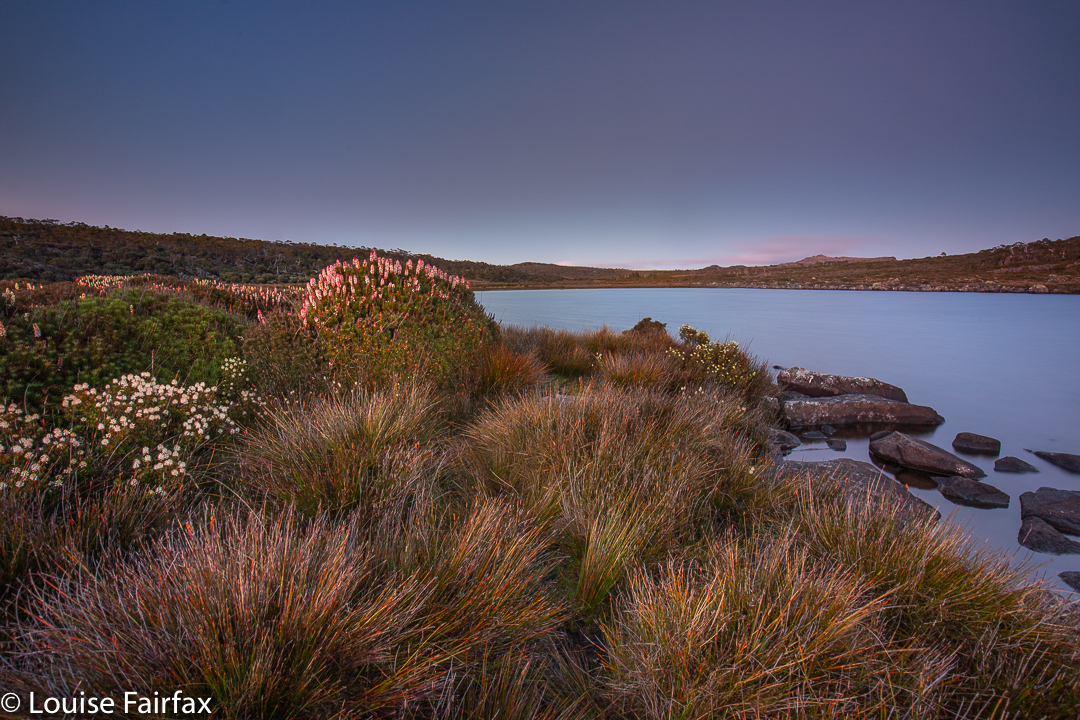
Richea scoparia greets the dawn at Lady Lake Off I set, exploring channels, finding a waterfall, and then going to the lake where I found wallabies and colourful wildflowers. During the final splash of colour at Alpenglow, I shared the last of the beauty with the others from the hut out on the verandah. Next day, I enjoyed a kind of repeat of wildlife, wildflowers and lake in beautiful pre-dawn colours by setting my alarm for five in the morning and braving the bracing temperatures to experience pink-hour beauty.
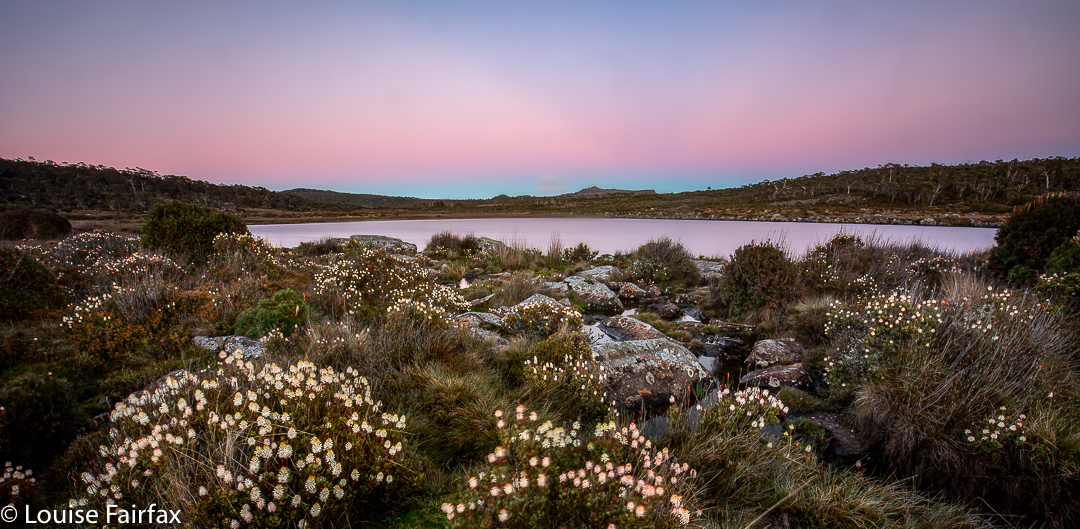
Pink hour, pre-dawn at Lady Lake 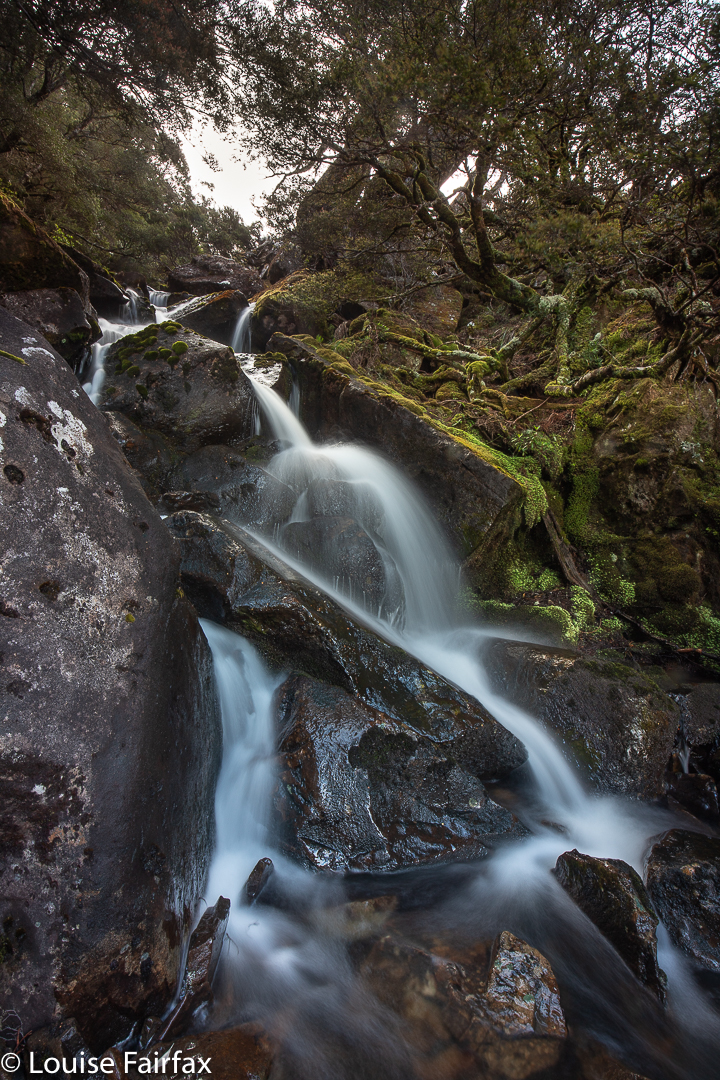
Dale Brook Falls, the waterfall I found. According to a strict reading of the map, this waterfall is actually on a tributary of the main Dale Brook, but I decided including that in the name was too much of a mouthful, so have just named them (unofficially) as what you read here. For winter views, see www.natureloverswalks.com/lady-lake-snow/Cataract Gorge Launceston “Tomorrow”.
Cataract Gorge Launceston “Tomorrow”
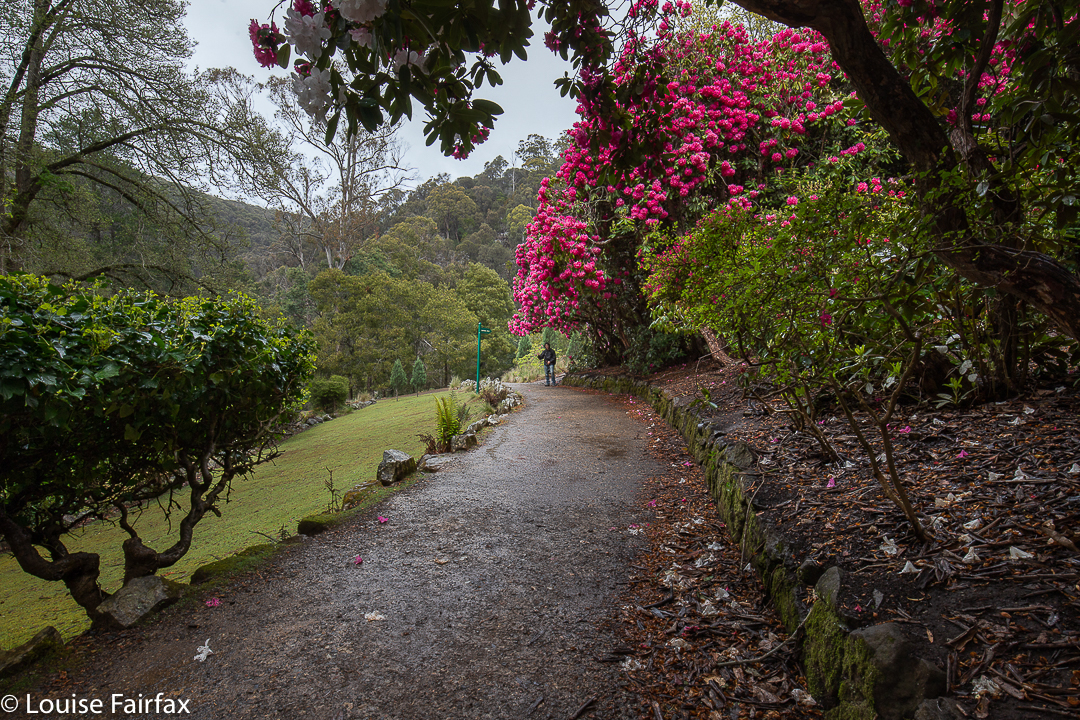
T. Tourist in Tree Tunnel I never expected to have so much fun in Cataract Gorge. After all, I run there every day, so it holds few secrets, and it is becoming alarmingly popular of late. So why was I there in a role other than “daily runner”? Haven’t I had enough of the place? (No, is the short answer).
My Camera Club, NTCC, is having a ‘fun afternoon’ there later this month; however, I can’t attend as I will be climbing a truly horrible mountain on that day. But I wanted to play the party game, even if I can’t attend the party, so here I was. It was raining this morning, precluding many other duties: today was to be the day. And what was this game? I had an 8-letter word, (mine was “tomorrow”) and I had to find something to photograph for each letter of my word.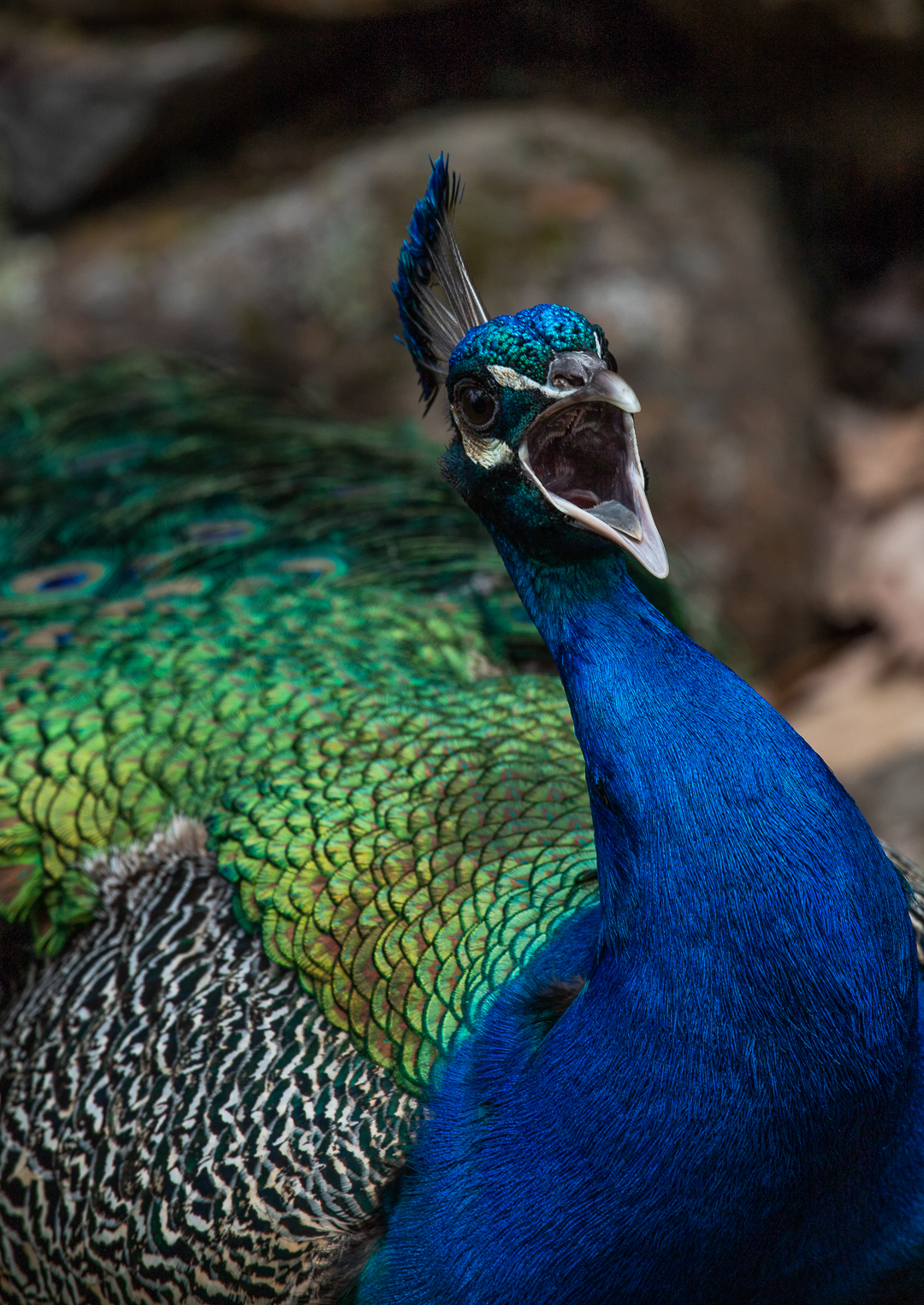
O. Orifice (oral one) of opalescent peacock (yelling) While I did my post-breakfast run, eyes left and right for inspiration, I considered my lot. The consonants were easy, but three Os. Oh dear. As I ran, I hoped I would happen upon an Olearia; that would make life easier. Yes, I caught it on the rebound up towards the Power Station. Phew. That was one O dispensed with. I have never seen an orchid in the gorge, and the only fungus specimen I know beginning with O (Oudemansiella gigaspora), I had only seen on Mt Wellington, so I’d have to think outside the botanical square for two more. I ran and dreamed. You will see in the photos my solutions to my problem.
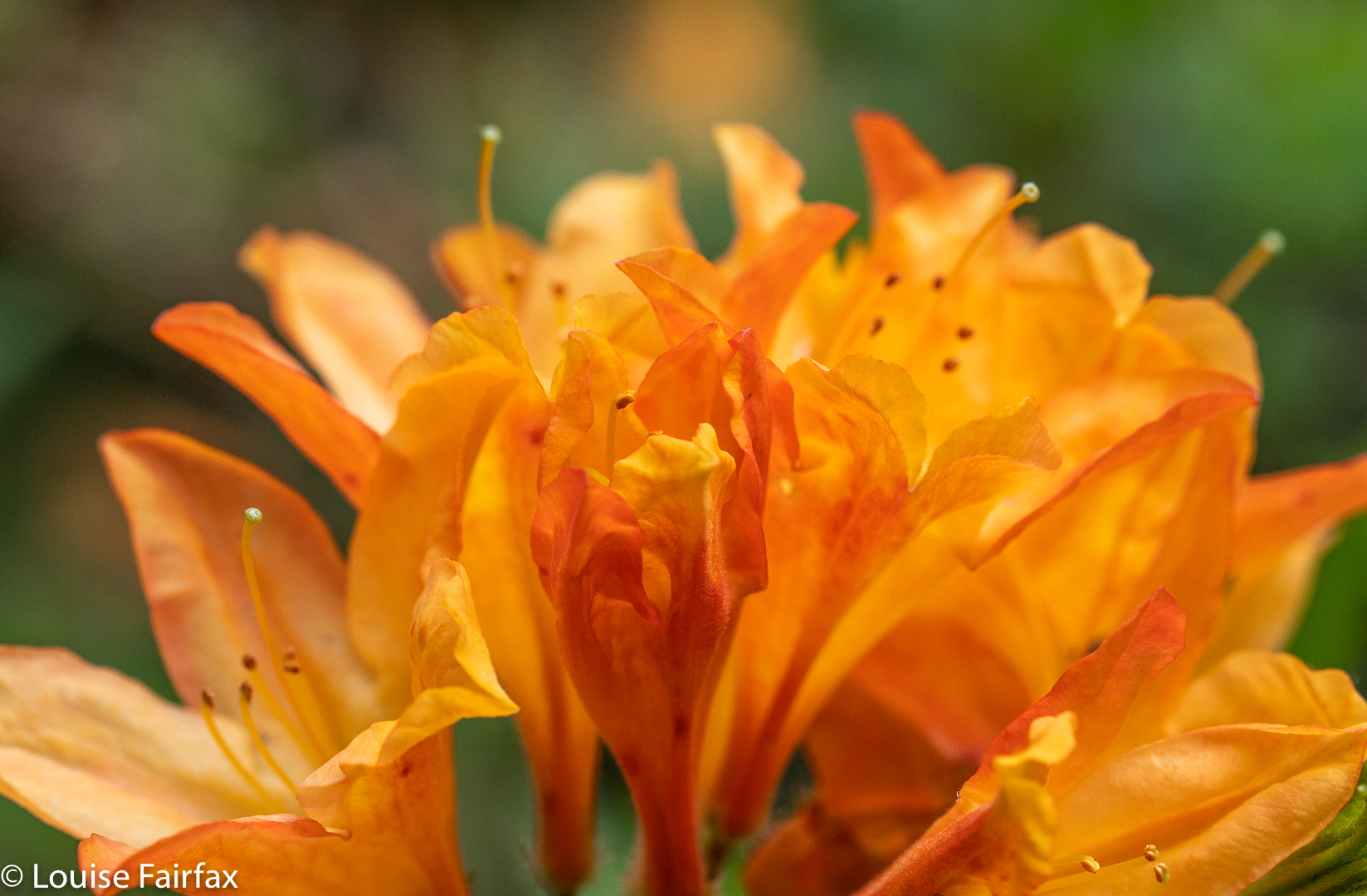
Mollis azalea (Macro) My only other issue was selection, as my mind was working overtime, coming up with far too many fun alternatives. Oh well. I’d shoot anything and everything, and decide later which ones would be in the final cut.
I grabbed my camera backpack, and swapped my running shoes for walking boots and gaiters, as I was about to follow one of the South Esk River’s tributaries upstream for my W shot. That was fun. As I dived over the edge of the railing, I heard a father steer his curious son away; I think he decided I was someone suspicious, or, at the least, very strange. I am sure I am thought to be Very Strange quite often, so this only caused a smile.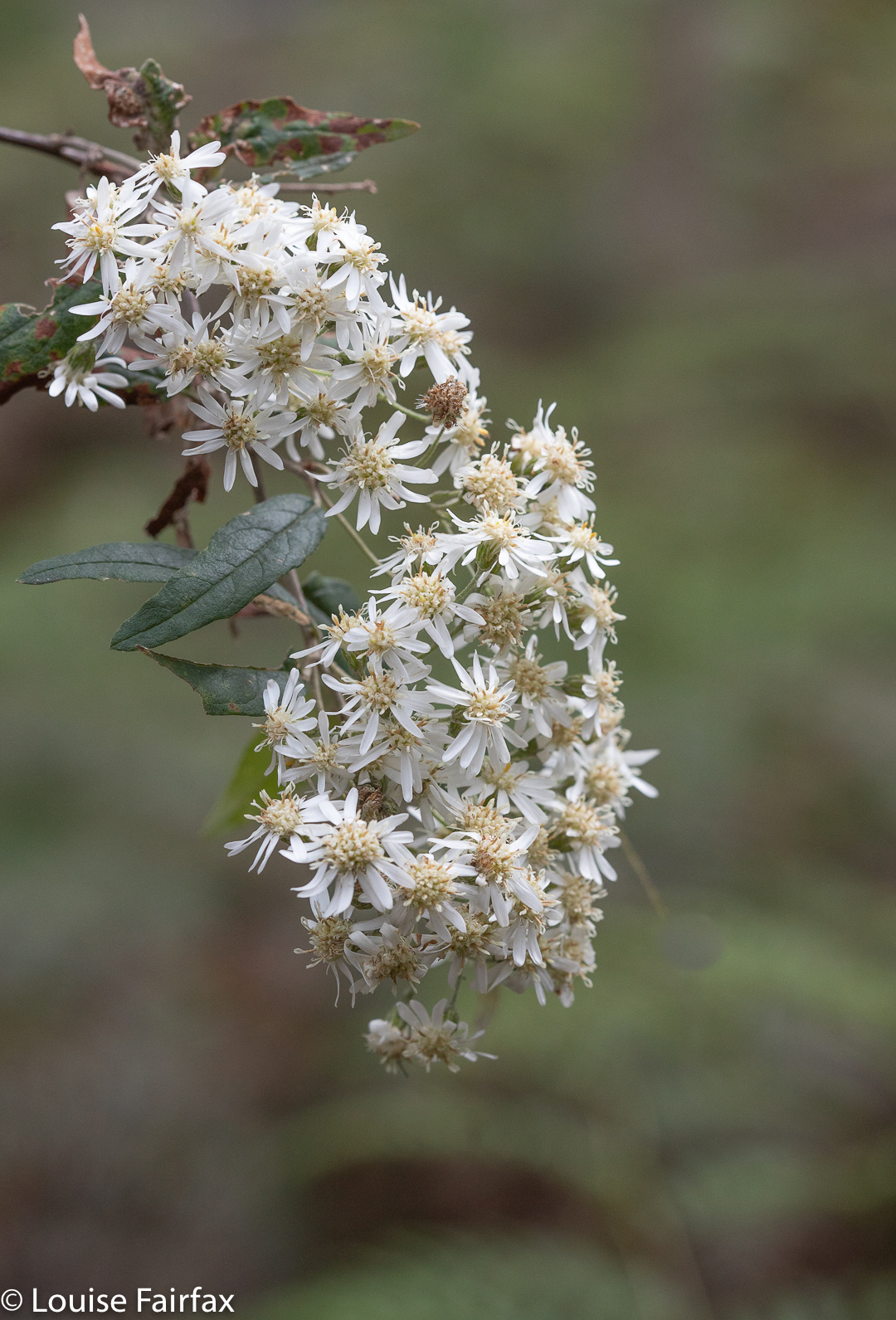
O. Olearia (overhanging) W well and truly covered (with a bit of beautiful M thrown in for good measure), I transferred location to the Rotunda with its Rhododendrons (ignoring the Runners, Rain and Rocks). While I was photographing the path with its colourful overhang, there, beautifully framed by the crimson arch, was a Tourist, who signalled to me that he’d move. What? A considerate tourist? Is that not an Oxymoron? I didn’t think I needed T for tourist, but thought this Oxymoron could be an Obnoxious Oggling Obstruction. However, I then met him – he was not just a tourist; he was also a fellow photographer; of course he had manners. He was even a bit of an Ornithological cognoscente. However, after all those fine Os, I decided I would like him as my T, despite my myriad tree photos, including a double-up of Tilia.
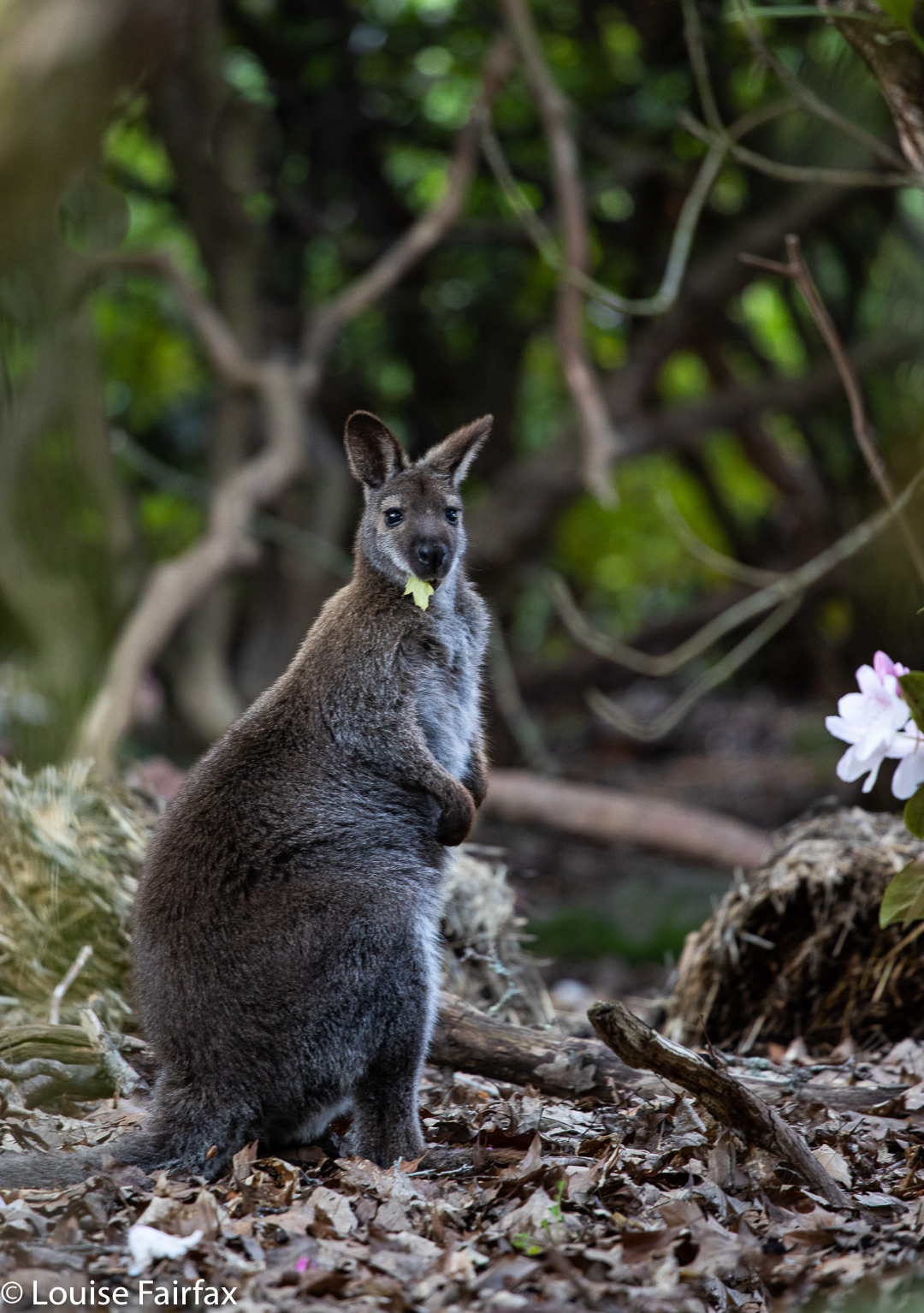
R. A roo, who is actually a wallaby, but so much cuter than the Rotunda, and even better than all my beautiful Rhododendron photos. We chatted for about an hour, laughing together about some of the possibilities for my letters, and touching on the paradigm shift between the seventeen and eighteen hundreds, David Caspar Friedrich’s influence on the Romantic artists (and our mutual admiration of his work), the embracement of chaos as part of the enlightenment and more. It was so, so very relaxing to talk to someone about topics like this. Part of my ache for Bruce is that such conversations are now a rarity for me. Greg, btw, is a beautiful photographer. You can check him out on his web: www.gregsoandso.com.au.
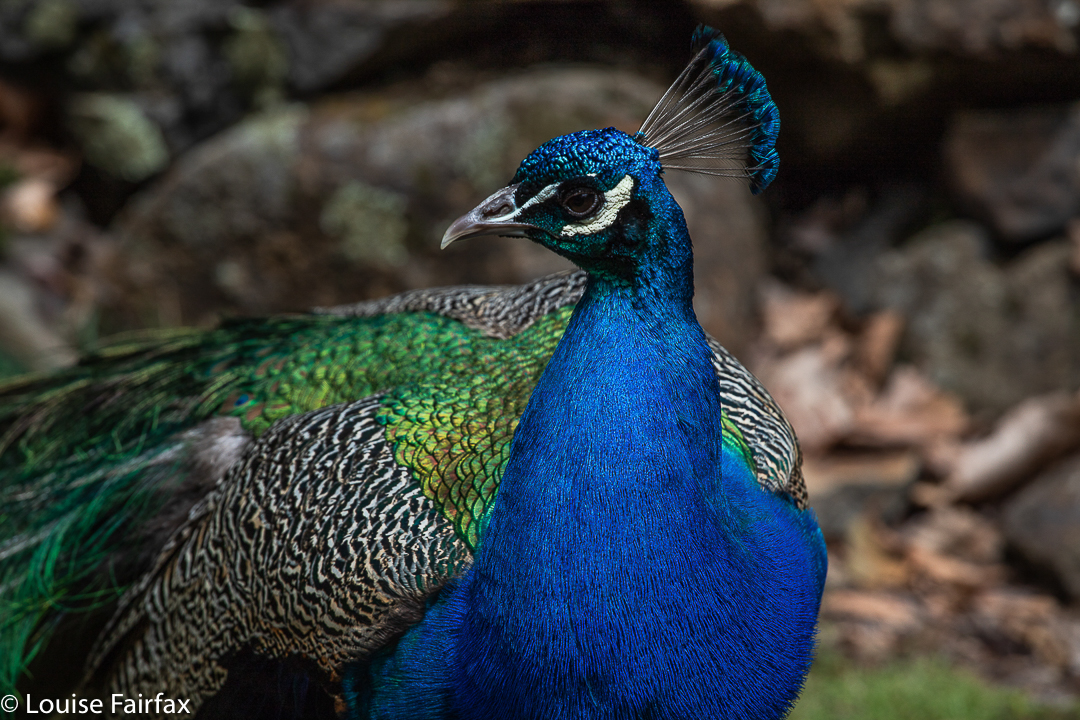
R. Regal Royal blue, with Reckoning eye (with further apology to the Rotunda and Rhodies). I went up and changed lenses from wide angled to zoom. Soon enough I yelled out excitedly to Greg who reappeared that I’d found another O; I had just photographed the quintessence of Opalescence. This game was such fun.
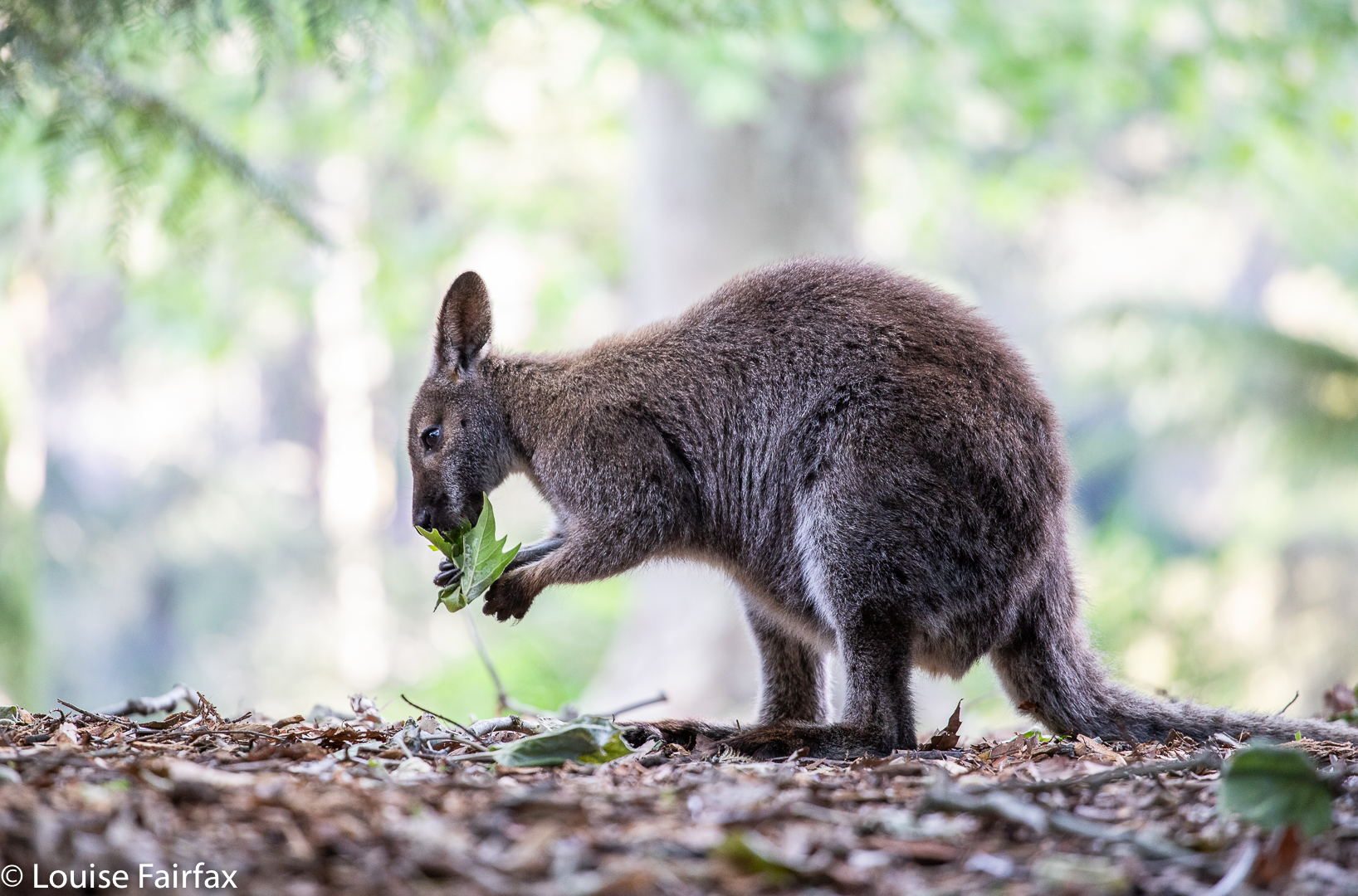
O. Orifices – but wallaby ones this time. And you can concentrate on the ear to make it different. A female came running by. I already had too many Rs, and didn’t need an F, but shot the Runner just in case. Satisfied, I began my journey back to the car, but bumped into a bushwalking friend, and had a chat, by the end of which this game had occupied nearly four hours! I was, predictably, starving. Just a bit more Moss in case I decided I needed it, and an appealing Rock, again, just in case, and I was away. … But not quite. On a different visit, I had taken a photo of a possum whose Orifices were quite prominent. I wanted a good marsupial orifice. I would come back in the evening to try my luck on a repetition. Otherwise, I’d use a rather cheeky one taken this morning. I like games.
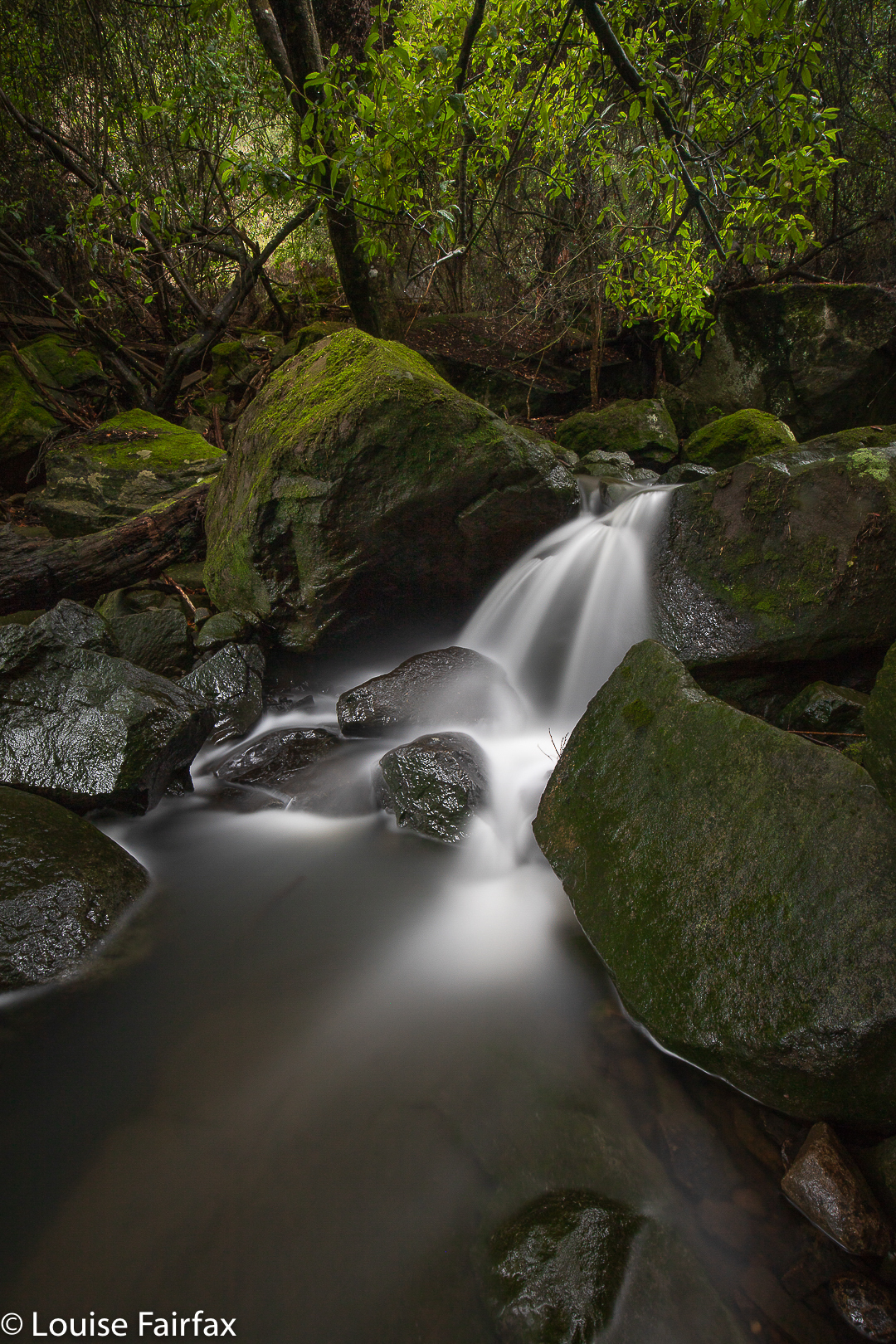
W. Come on, it wouldn’t have been me not to find an excuse to sneak a Waterfall in somehow. You only know about things like this if you explore the gorge’s secret places. T might be for tomorrow, but the gorge is a Treasure chest for its many lovers. Lobster Falls 2016 Nov
Perhaps you don’t think a visit to the Lobster Falls is an adequate – or even likely – substitute for a multiday trek in the South West connecting glorious mountains, but, alas, there are some days when you have to admit defeat, and today was one of them. Unfortunately, the combination of my bronchitis, which has now been keeping me company for five weeks, and the forecast of heavy rain, driving winds and gelid temperatures on high didn’t seem like a happy marriage. I backed out before walking down the aisle, deciding that a little run, some Pilates and a walk to these as yet unvisited falls would be a healthier option.To get to the start, we drove along out of Deloraine in the direction of Chudleigh. After seeing a sign to the Needles on the left, I knew to look out for a blue and white sign to the Lobster Falls (which are on the Lobster Rivulet) to the right. Near that sign is another one which says no cars should proceed beyond that point. I ignored it for 50 ms to get the car away from the main road. There was a clearing there for parking.
Something VERY heavy has been down the road that formed the early part of the walk, making the ground exceptionally soft and causing huge indentation. There was a particularly gooey section – which lasted a mere 70 ms – where going through the bush was more pleasant than being on the road. When Tessa (dog) sank in up to her stomach (portly) she, too, took the firm bush option. Don’t be put off by this. it is short lived, and the bush is quite open at this point to allow easy passage.

Bauera rubiodes
At twelve minutes from the car, we came to a metallic white arrow with pink and blue ribbons attached, pointing to a track to the right leading off this “road”. Now, a very pleasant route became an exceptionally beautiful one. In four minutes from the arrow, we rounded a corner and found ourselves looking down on the Lobster Rivulet which we now followed to the falls. Overhanging the path were myriad wildflowers in yellow, mauve, rose, light pink and white – bauera, boronia, olearia, acacia, oxylobium and more. There were even plenty of orchids (caladenia alpina).In sixteen minutes from that corner (and thus, about half an hour from the car), in a pace that was neither rushed nor a saunter – just a nice steady walk – Tessie was having a dip and I was setting up my tripod. Bruce has Parkinson’s disease, so elected not to come all the way down to the water’s edge, but the section that was narrow with a drop had plenty enough bushes to take away the scare factor for him (well, he was probably taken to his limit, but did not go over it). He could see the falls perfectly well from where he waited, so was not denied much by not doing the final twenty metres steep descent.I was now starving. Time for an ice-cream at the Honey Farm to tide us over so we could get all the way to the Raspberry Farm for lunch. Humans and dog enjoyed the outing.
Kangaroo Island Wilderness Trail Wildflowers
Kangaroo Island Wilderness Trail, wildflowers.
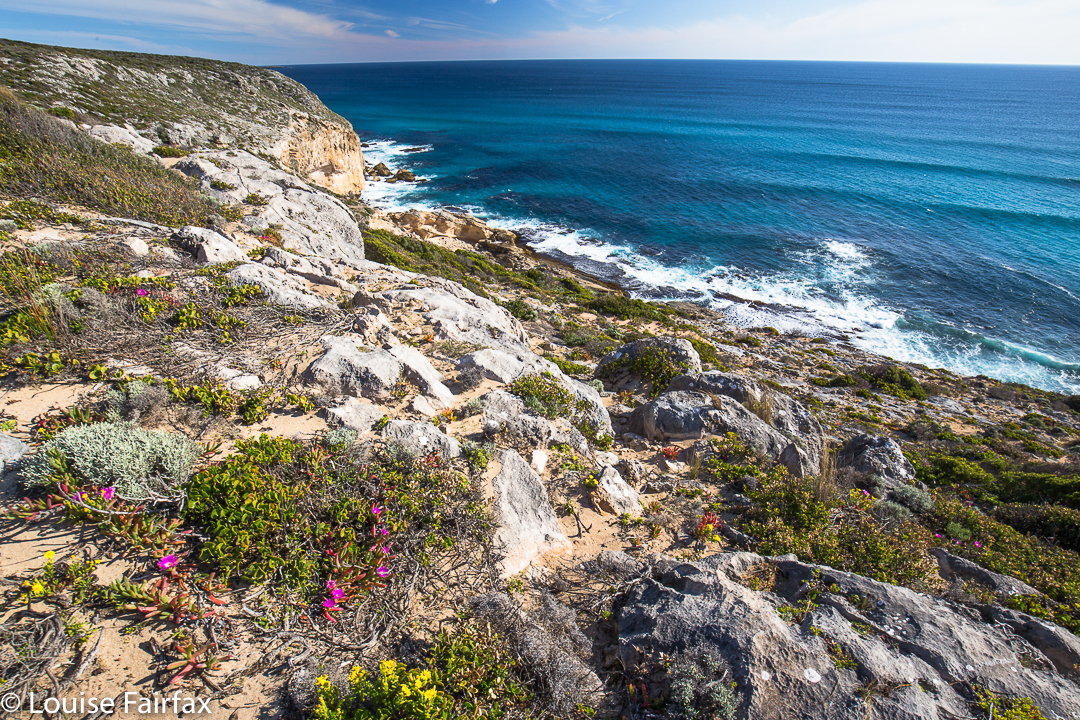 Pig face (carpobrotus) and hibbertia sp along the coast, day 2
Pig face (carpobrotus) and hibbertia sp along the coast, day 2Kangaroo Island Wilderness Trail abounds in wildflowers. Here are the names of some I have been able to identify that I saw as I walked along the trail. The length of the list speaks volumes for the fabulous diversity to be found. Thanks to the fabulous Alison Buck for checking and helping me with the list. Any errors are mine, not hers. (On Monday I will post my account of walking the trail).
acacia paradoxa (this filled the scenery for several early sections of day 1)
boronia edwardsii (broder leaf than the one below)
boronia filifolia (fine leaf, sandy section)calytrix smeatoniana (a paler calytrix than the one below)
calytrix tetrogona (wonderful pale pink)carpobrotus rossii (pigface; bright pink)
chamaescilla corymbosa (blue squill, or blue stars; wonderful delicate mauve flowers. A tuberous herb with grasslike leaves)
cheiranthera alternifolia in early forested section – another delicate mauve flower
correa decumbens
dampiera lanceolata
daviesia asperula (one of many ‘eggs and bacon’ pea flowers)
euphrasia collina (mauve pea family; eye bright)
goodenia blackiana
goodenia ovatagrevillea quinquenervis (pink spider plant)
grevillea halmaturina (white spider flower)
grevillea rogersii (just two spider legs in kind of pairs, darker red)hakea rostrata (delicate white spider flower with needle leaves)
hakea vittata (hooked needle wood; low growing)hibbertia riparia
hibbertia acicularis
hibbertia virgatalasiopetalum discolour (velvety leaves, mauve) (sorry, refuse to spell colour the american way, especially when it is an Aussie flower)
lasiopetalum schulzenii (hanging bells of cream)leucopogon parviflorus (divine smell. How I wish I could preserve it. It filled the air with its delicacy at times on day 1).
olearia taretifolia (tiny white daisy flowers on a bush)
orthrosanthus multiflorus (mauve morning iris)
pimelia sp (there are several species of pimelea on the island)
pomaderris obcordata (small [20 cm high mostly] clumped pant covered in with tiny white or pinkish flowers)
prasophylium elatum (snake orchid – near campsite at the end of day 2)
prostanthera spinosa (dark mauve; prickly leaves)
pultenaea daphnoides (large leaf pea flower; egg and bacon colouring; beautiful perfume)
pultenaea scabra (a different egg and bacon flower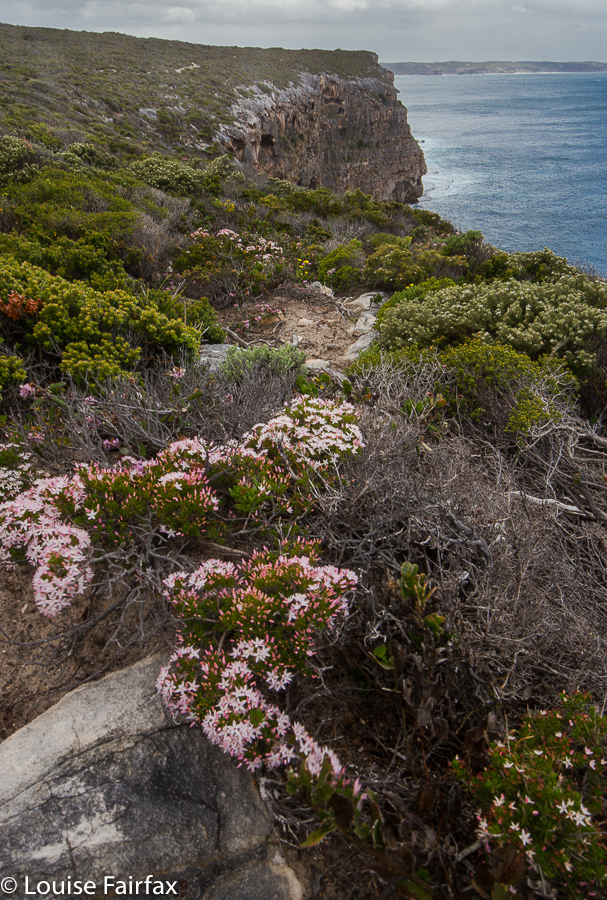
More calytrix lining the path
scaevola linearissenecio lautus (yellow daisy flower)
stackhousia aspericocca
swainsona lessertiifolia – a small mauve pea flower with many erect stems
Tetratheca halmaturina (see below)
thelymitra epipactoides (delicate mauve sun orchids)
wahlenbergia multicaulis
xanthorrhoea semiplana
(My favourite of the several ‘koala trees’ was eucalyptus viminalis cygnetensis – great for humans to climb, too – which not many eucies are). I also enjoyed the huge eucy camaldulensis exemplars, especially those on the last day growing by the river, and, to a lesser degree, the cup gums, sugar gums and coastal mallee gums that decorated our walk.
